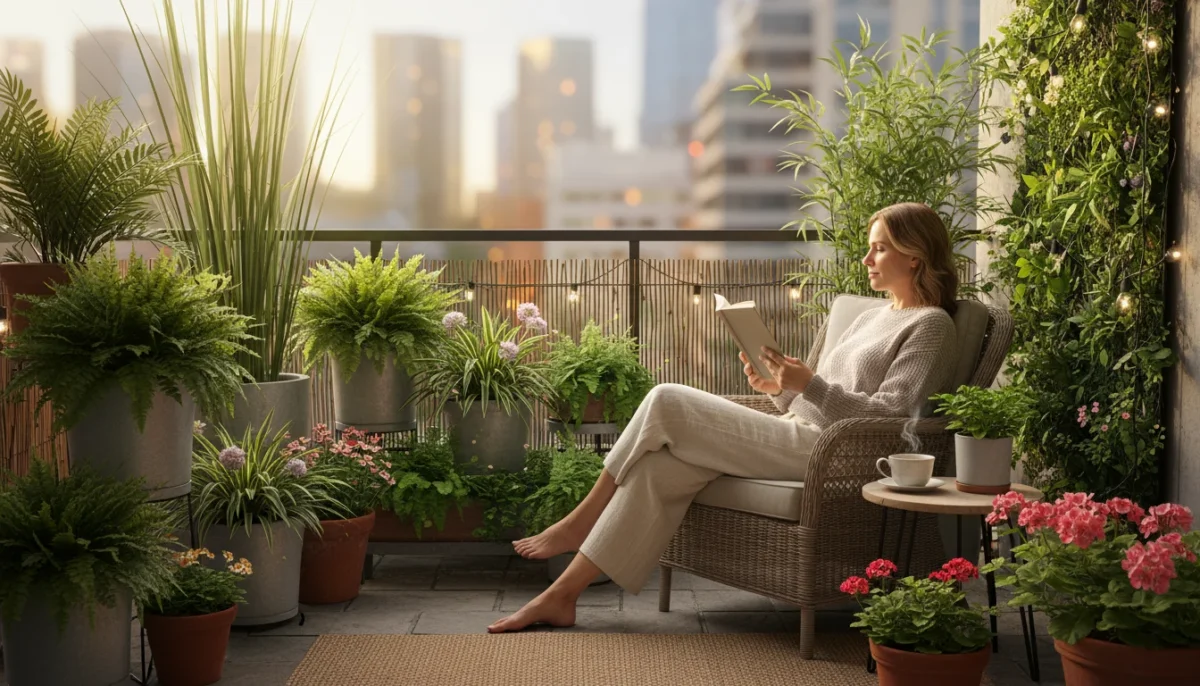Your outdoor space, no matter its size, serves as an extension of your home. It offers a place for relaxation, entertaining, and connecting with nature. Yet, often, a lack of privacy can diminish these experiences. Overlooking neighbors, busy streets, or an exposed balcony view can make your garden feel less like a sanctuary and more like a public display. Creating a private oasis transforms your patio, balcony, or compact yard into a personal retreat, fostering comfort and a sense of enclosure. Plants offer an ideal solution, providing not only effective garden screening but also beauty, fresh air, and a living, evolving backdrop.
This guide empowers you to design and implement plant-based privacy solutions for even the smallest outdoor areas. We focus on practical, low-maintenance, and environmentally conscious approaches, ensuring your green screen thrives and enhances your space for years to come. You will discover how to select the right outdoor privacy plants, utilize vertical gardening techniques, and strategically place containers to achieve the seclusion you desire.
For design and plant selection guidance, visit
University of Minnesota Extension,
Cornell Garden-Based Learning,
UF/IFAS Gardening Solutions and
Oregon State Extension — Gardening.
Disclaimer: This article is for informational purposes only and is not a substitute for professional advice. Consult local extension services for region-specific recommendations.
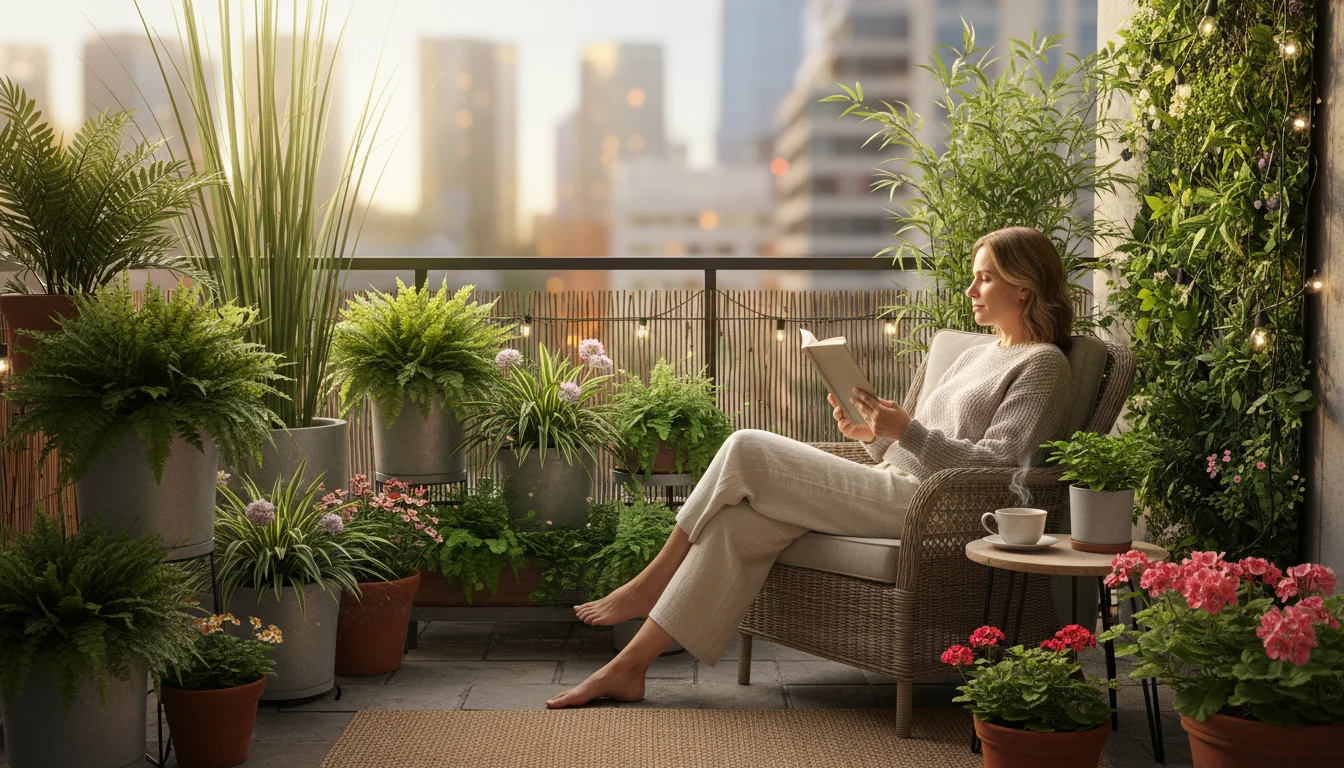
Why Privacy Matters in Your Outdoor Space
Your outdoor area functions best when it feels like a true extension of your home, a secluded spot where you can unwind without feeling exposed. Privacy contributes significantly to this sense of comfort and ownership. Imagine sipping your morning coffee or reading a book outdoors, knowing you enjoy complete seclusion. This creates an inviting atmosphere, encouraging you to use your balcony, patio, or compact yard more frequently. Effective garden screening transforms an open, visible space into an intimate retreat, enhancing both its usability and your quality of life.
Privacy also helps define your outdoor room. Just as walls delineate rooms indoors, plant screens create boundaries outside. These living walls give your space structure, making it feel more intentional and cohesive. They block undesirable views, reduce visual clutter, and help soften ambient noise from neighbors or nearby streets. Psychologically, a private space reduces stress, offering a calm environment where you truly relax. You invest in your well-being when you invest in outdoor privacy plants.
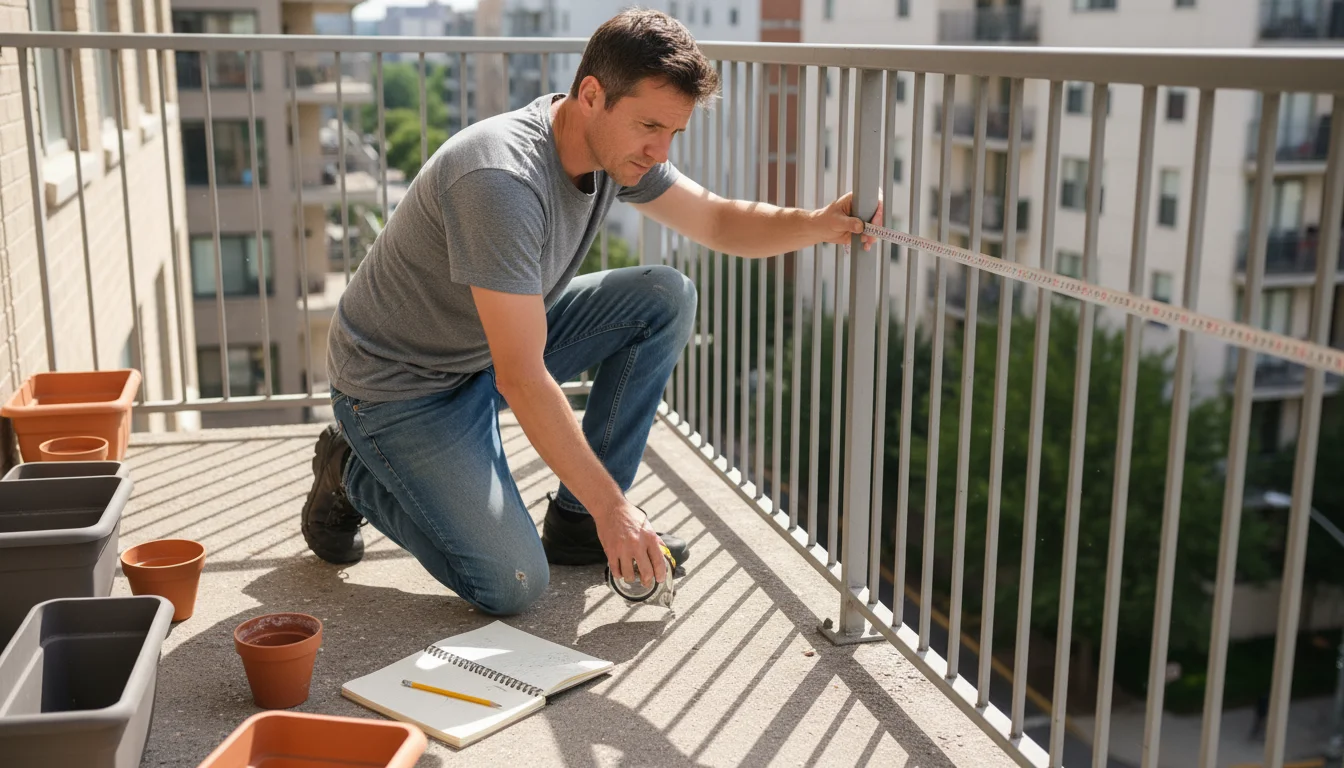
Designing Your Privacy Oasis: Planning for Success
Effective privacy starts with a thoughtful design. Approaching your small space strategically ensures you achieve maximum seclusion and beauty without sacrificing functionality. This planning phase saves you time and resources, guaranteeing your balcony privacy garden serves your needs perfectly. Begin by understanding your space and your specific privacy requirements.
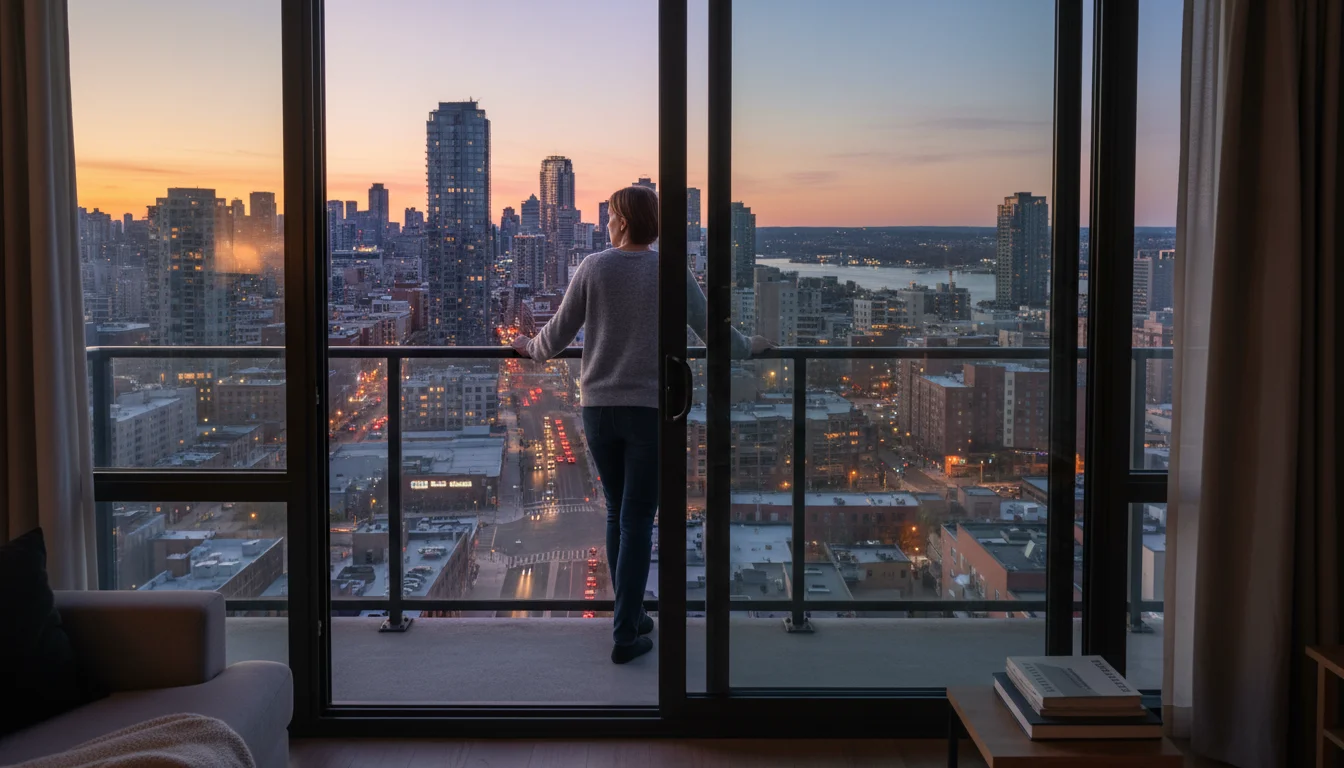
Identify Your Privacy Needs
Walk through your outdoor area and observe it from different vantage points, including from inside your home looking out. Note where you feel most exposed and where undesirable views intrude. This could involve direct sightlines from a neighbor’s window, an alleyway, or even a busy common area. Consider the times of day you use the space most often, as sun angles and neighbor activity can change privacy levels throughout the day.
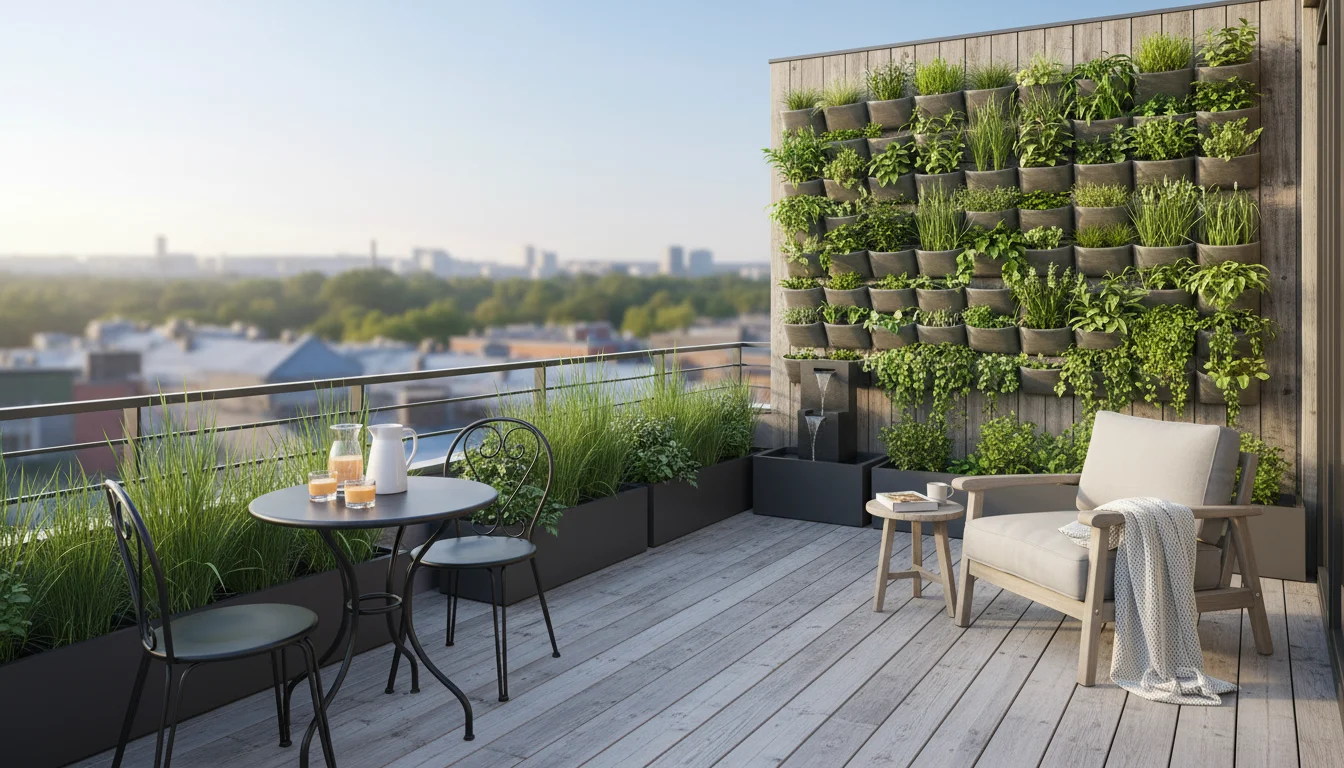
Map Your Space and Create Zones
Draw a simple sketch of your outdoor area. Indicate existing structures, doorways, seating areas, and any potential focal points. A focal point is the first thing your eye notices when you enter a space, often a striking plant, a piece of art, or a small water feature. Think about how you use your space and define different zones: a dining area, a lounge spot, or a quiet reading nook. Zoning helps you decide where garden screening is most crucial.
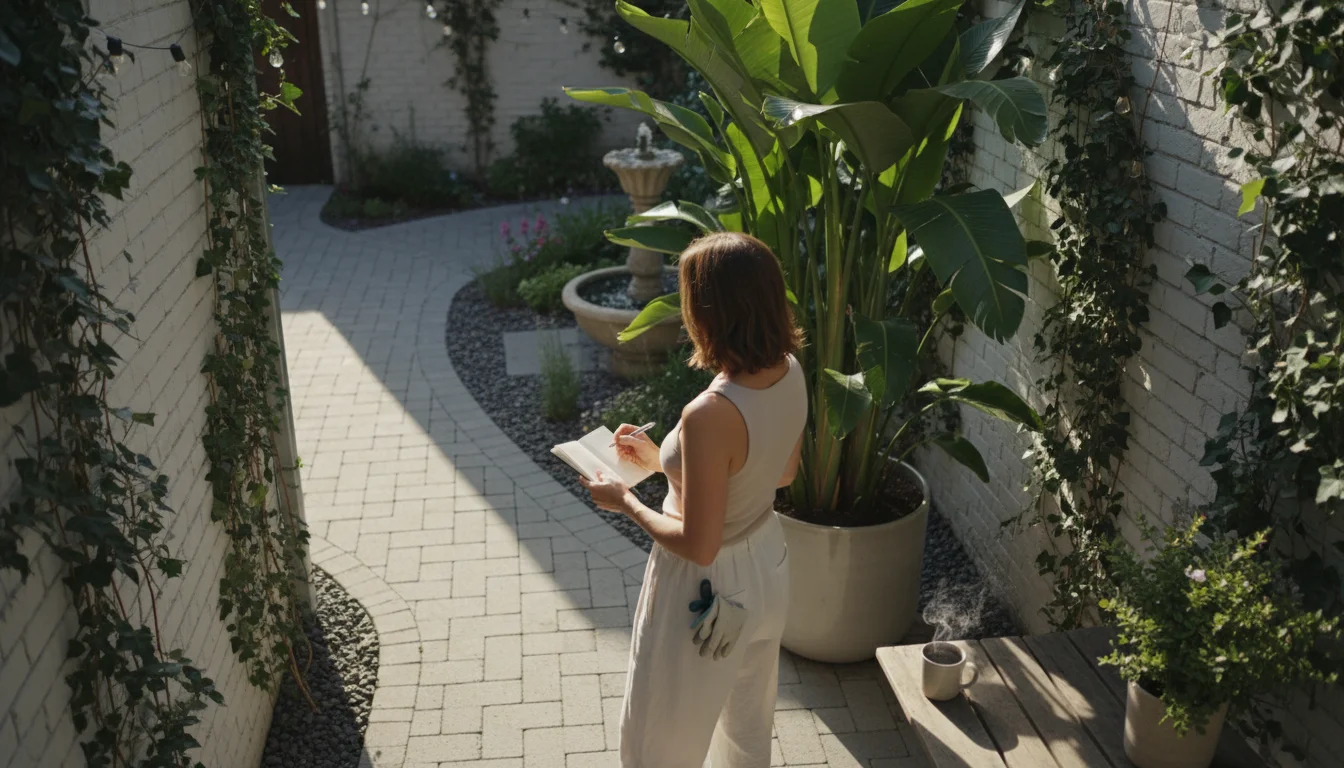
Assess Sightlines and Traffic Flow
Once you identify problem areas, you can strategically place outdoor privacy plants. Consider both horizontal and vertical sightlines. Do you need to block views at eye level while seated, or from an upper-story window? Maintain clear pathways, ensuring your privacy solutions do not obstruct movement. Good traffic flow ensures your small space remains functional and easy to navigate.
When planning, remember the importance of adequate clearances around seating and pathways. These measurements prevent your space from feeling cramped and ensure comfortable use:
| Area | Recommended Clearance | Rationale |
|---|---|---|
| Main Pathway | 36 inches (90 cm) minimum | Allows comfortable passage for one person or easy navigation with small items. |
| Secondary Pathway | 24 inches (60 cm) minimum | Suitable for less frequently used paths or access between planting areas. |
| Behind Seating | 30 inches (75 cm) minimum | Allows for easy movement when pulling chairs in and out, or walking behind seated guests. |
| In front of Key Features (e.g., grill, storage) | 36 inches (90 cm) minimum | Ensures safe and comfortable operation or access. |
| Between Seating and Planters | 18-24 inches (45-60 cm) minimum | Provides space to stand up and move around without brushing against plants. |
By sketching out your privacy needs, identifying critical sightlines, and considering clearances, you lay the groundwork for a successful and beautiful balcony privacy garden. This deliberate approach ensures your plant choices and placement yield maximum privacy and enjoyment.
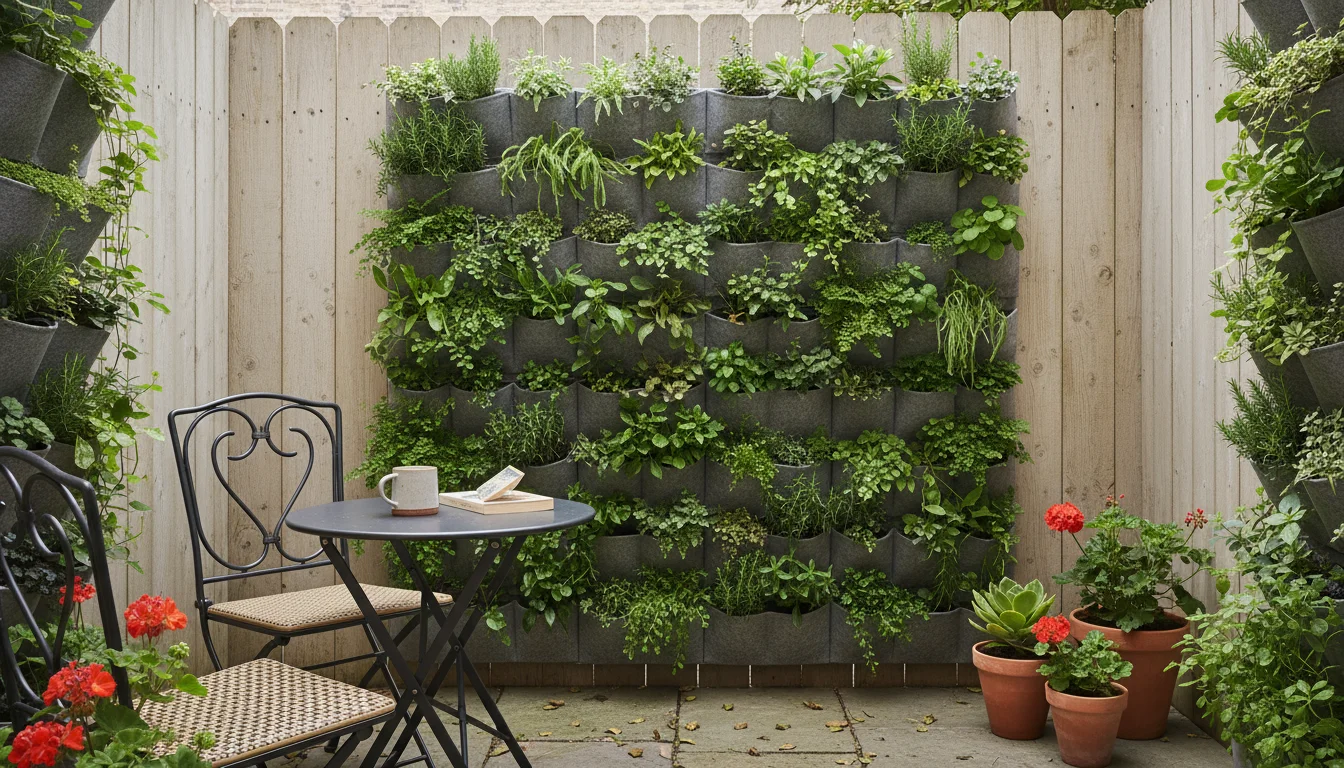
Vertical Green Screens: Maximizing Small Spaces
Vertical gardening offers a powerful solution for creating privacy in compact areas. When horizontal space is limited, you build upwards, transforming walls, fences, or railings into lush, living screens. These vertical elements not only provide garden screening but also add significant aesthetic value, making your small space feel larger and more vibrant.
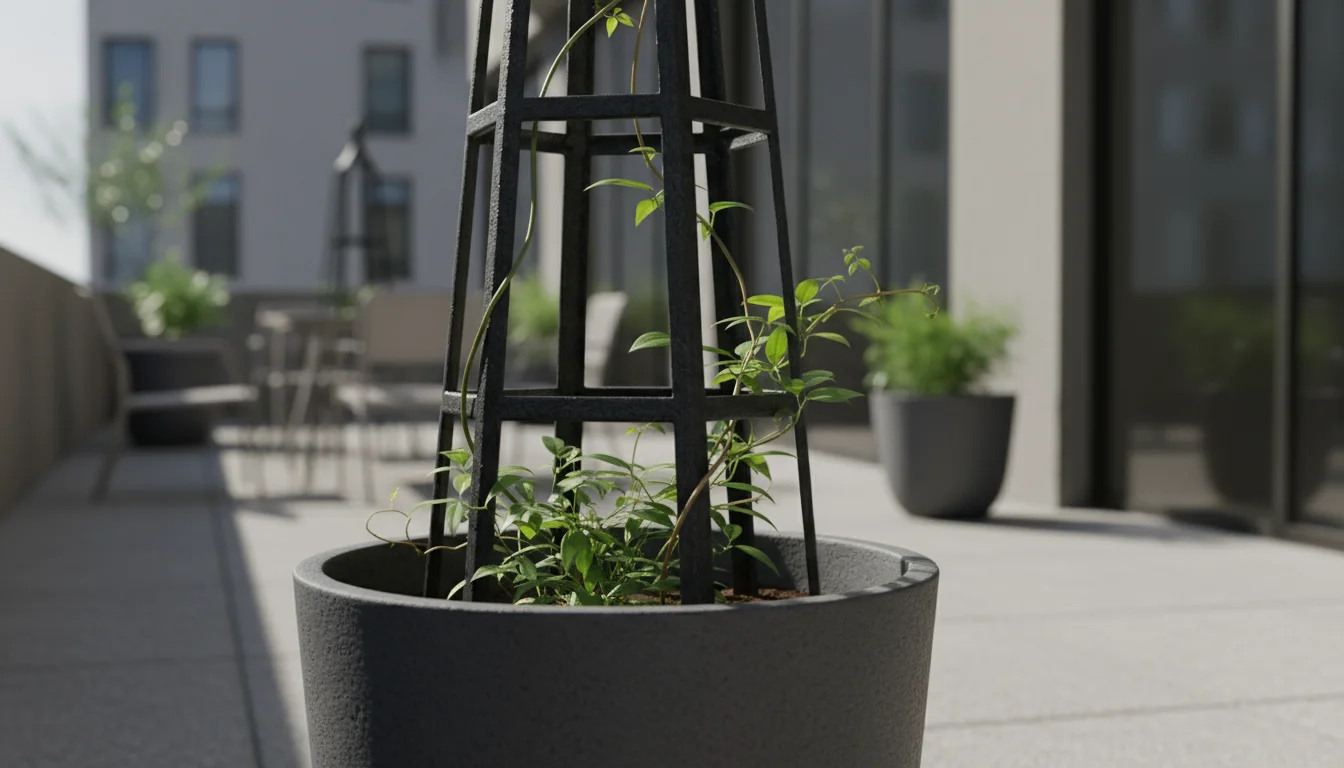
Trellises and Arbors
Trellises serve as foundational structures for climbing plants. They come in various materials such as wood, metal, or bamboo, and designs like lattice, obelisks, or simple grid patterns. Position trellises strategically along a fence line, against a wall, or even as freestanding dividers in larger patios. Select a sturdy trellis that supports the mature weight of your chosen vine. For a quicker screen, combine a trellis with a fast-growing climber like a native honeysuckle or an evergreen clematis.
- Lattice panels: Provide immediate partial screening even before plants cover them completely.
- Obelisks: Add vertical interest in a container, supporting a single climbing plant for a narrower screen.
- Modular trellis systems: Allow you to expand your green wall over time.
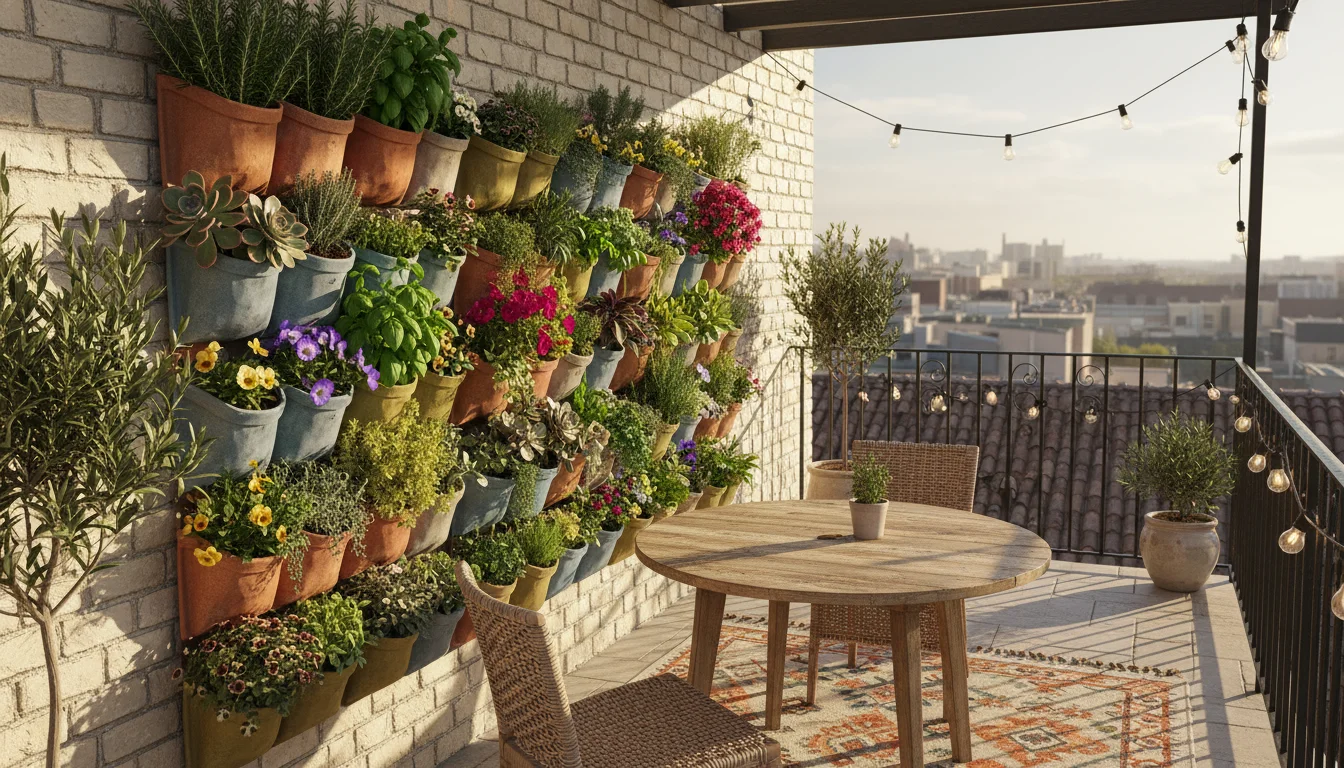
Wall Planters and Vertical Gardens
For true wall-mounted green screens, consider pocket systems or tiered planters. Pocket systems consist of fabric or plastic modules that attach to a wall, allowing you to grow a variety of plants in individual pockets. These work well for herbs, succulents, or smaller annuals, creating a dense green texture. Tiered stands, which offer multiple levels for pots, also contribute to vertical density. Choose plants with trailing or dense growth habits to maximize the screening effect.
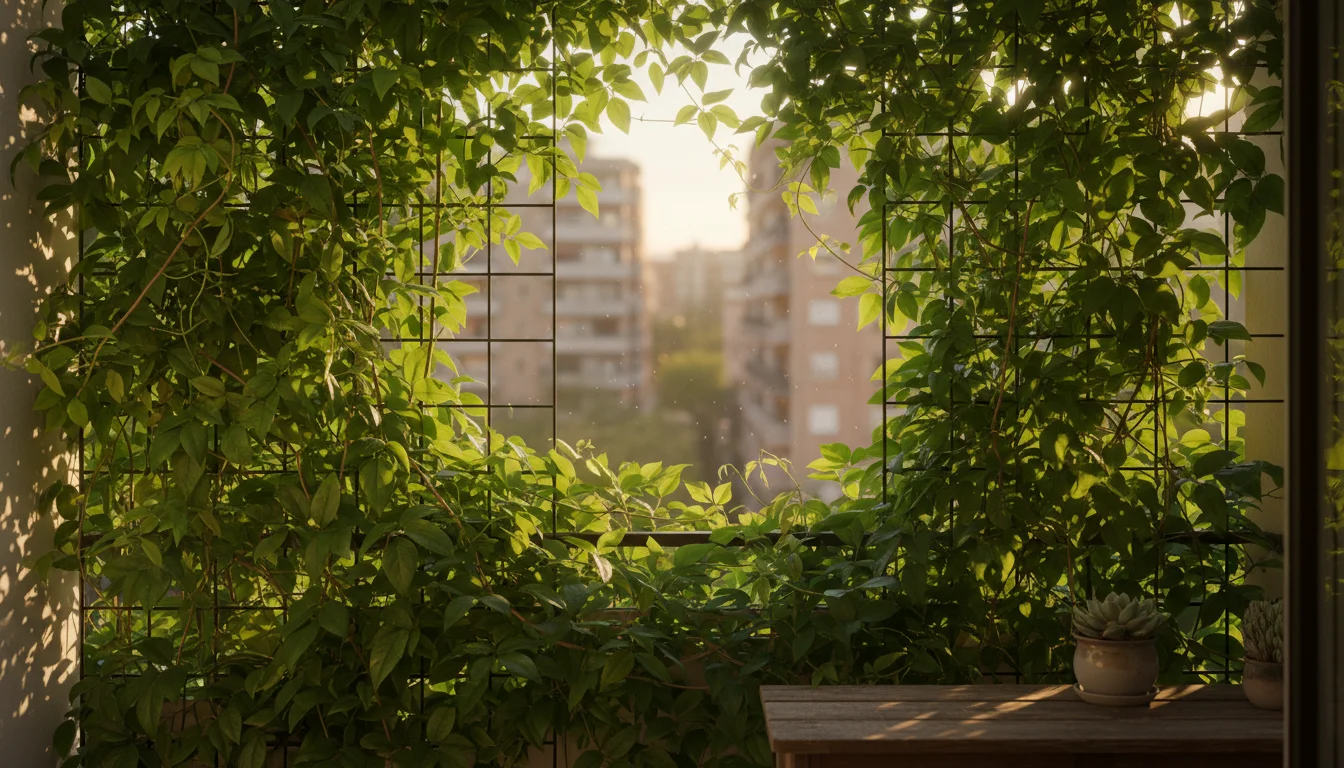
Choosing Climbing Plants for Vertical Screens
The success of your vertical screen hinges on selecting the right climbing plants. Consider their growth habit, mature size, and attachment method. Some vines twine, others cling with aerial roots, and some scramble. Ensure your chosen plant matches the support structure. Prioritize perennial options for long-term screening, or use annuals for quick, seasonal coverage.
Excellent Choices for Vertical Privacy Screens:
- Vines:
- Clematis: Offers beautiful flowers and dense foliage. Choose evergreen varieties like ‘Armandii’ for year-round cover.
- Honeysuckle (Lonicera sempervirens): A native, non-invasive option providing fragrant blooms and good density. Attracts hummingbirds.
- Climbing Roses: Provide both beauty and a dense barrier. Select thornless or fewer-thorn varieties for high-traffic areas.
- Star Jasmine (Trachelospermum jasminoides): Evergreen with fragrant white flowers, ideal for warmer climates.
- Boston Ivy (Parthenocissus tricuspidata): Fast-growing and self-clinging, provides excellent privacy and vibrant fall color. Ensure it clings to structures you want covered, as it can damage some surfaces.
- Shrubs trained as espaliers:
- Pyracantha: Thorny branches and dense growth make an impenetrable screen.
- Fruit Trees: Dwarf apple or pear varieties can be trained against a wall for a beautiful, edible screen.
When selecting plants, always consider your local climate and sun exposure. A plant thriving in full sun might struggle in a shaded balcony privacy garden.
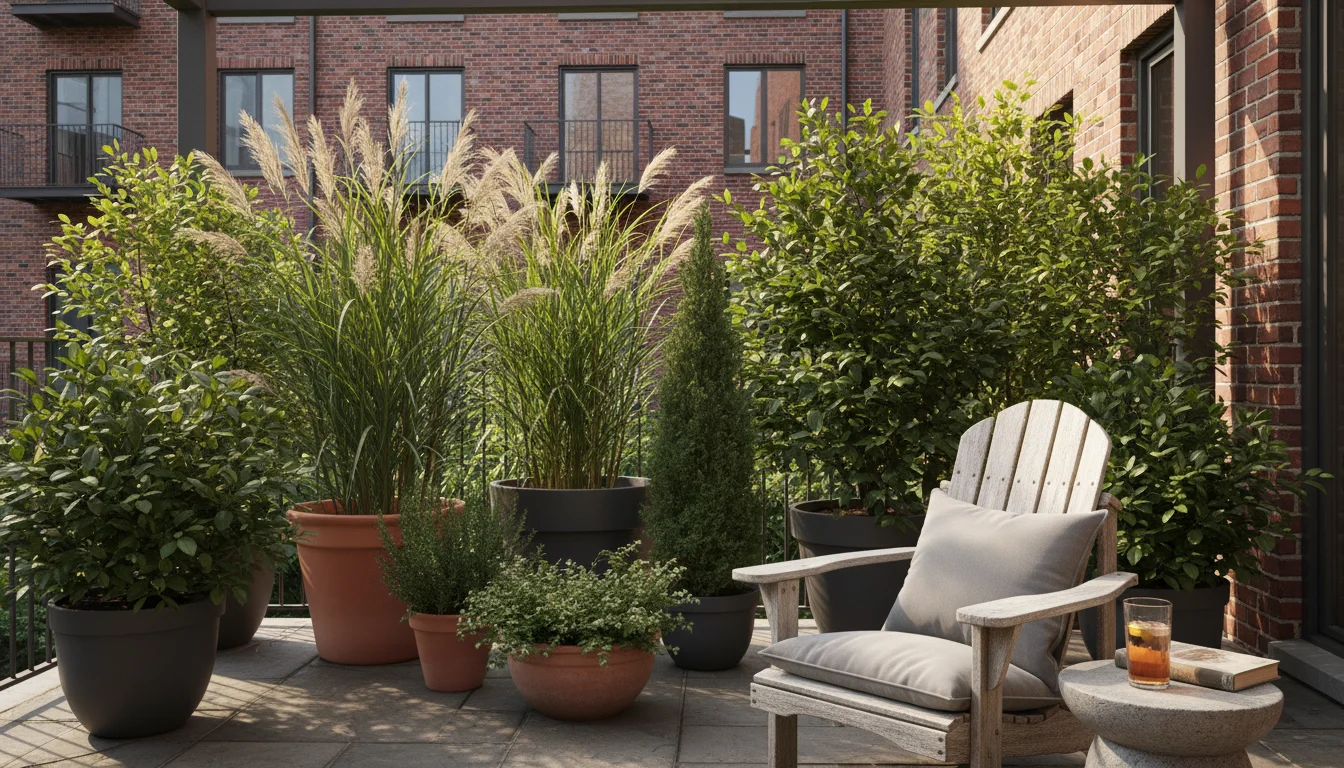
Strategic Container Plantings for Instant Screening
Containers provide unparalleled flexibility for creating garden screening. They allow you to introduce height and density precisely where you need it, and you can rearrange them as your privacy needs evolve. This strategy is particularly effective for balcony privacy gardens and small patios where planting directly in the ground is not an option.
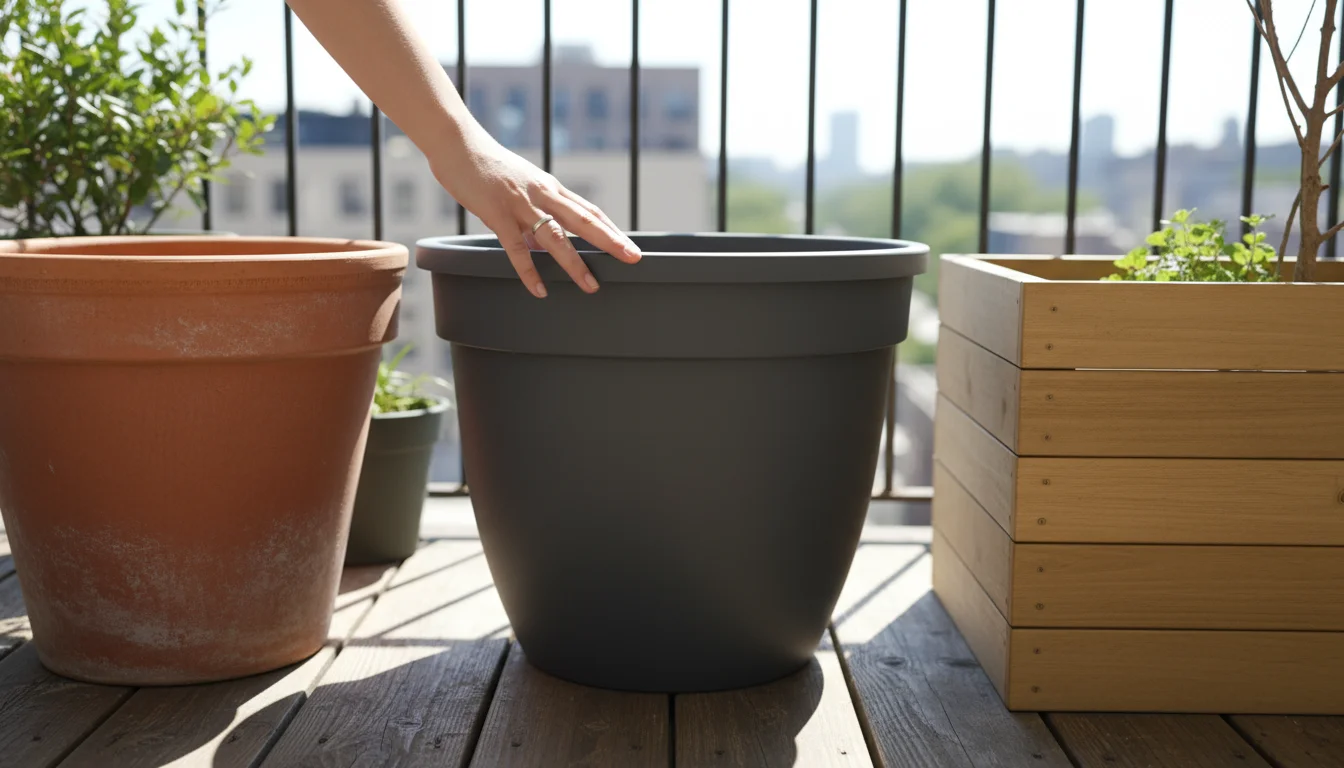
Container Selection for Impact
The size and type of container significantly affect the success of your privacy planting. Choose containers large enough to accommodate the root ball of your chosen outdoor privacy plants and allow for future growth. Deeper pots generally hold more soil, providing better insulation for roots and reducing watering frequency. For tall, screen-forming plants, a minimum pot diameter of 18-24 inches (45-60 cm) and similar depth is often necessary.
Container Materials and Aesthetics:
- Lightweight options: Resin, fiberglass, or plastic are ideal for balconies and rooftops, where weight is a concern.
- Terra cotta or ceramic: Offer classic appeal but are heavier and can dry out faster.
- Wood or metal: Provide a modern or rustic look. Ensure wood is rot-resistant, and metal has proper drainage to prevent rust.
Aim for cohesive materials or a complementary color palette for your containers to create a unified and attractive balcony privacy garden. Ensure every container has drainage holes to prevent root rot.
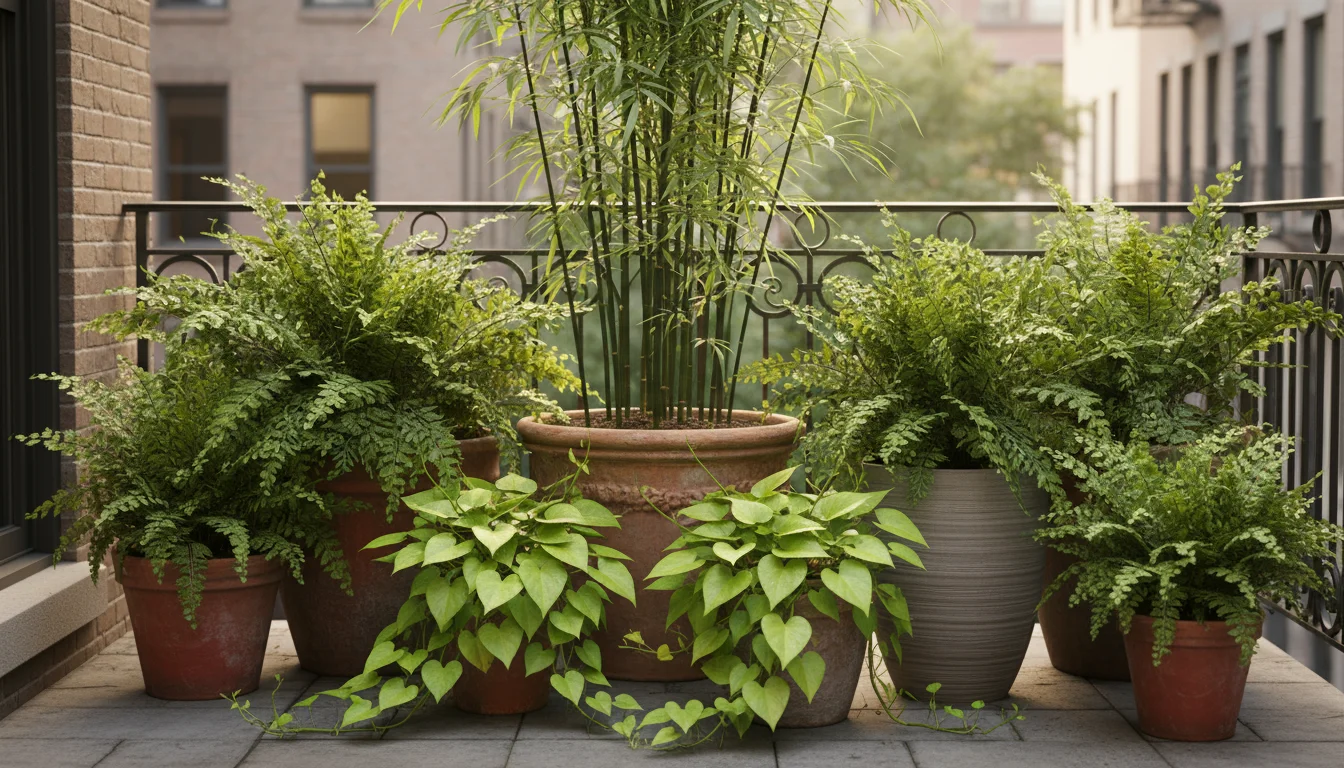
The Power of Grouping and Layering
Individual tall plants provide some screening, but grouping containers creates a more solid and effective barrier. Think of groups of pots as forming a living wall. Combine different heights and plant forms to create a layered effect. Place taller plants in the back, medium-height fillers in the middle, and trailing plants along the front. This “thriller, filler, spiller” concept, often used for container arrangements, works equally well for privacy, with the “thriller” acting as your primary screen element.
For example, a tall columnar shrub (thriller) can stand behind a denser, mid-sized perennial (filler), with a trailing vine (spiller) softening the edges of the pot. This creates a multi-dimensional screen that looks full and natural.
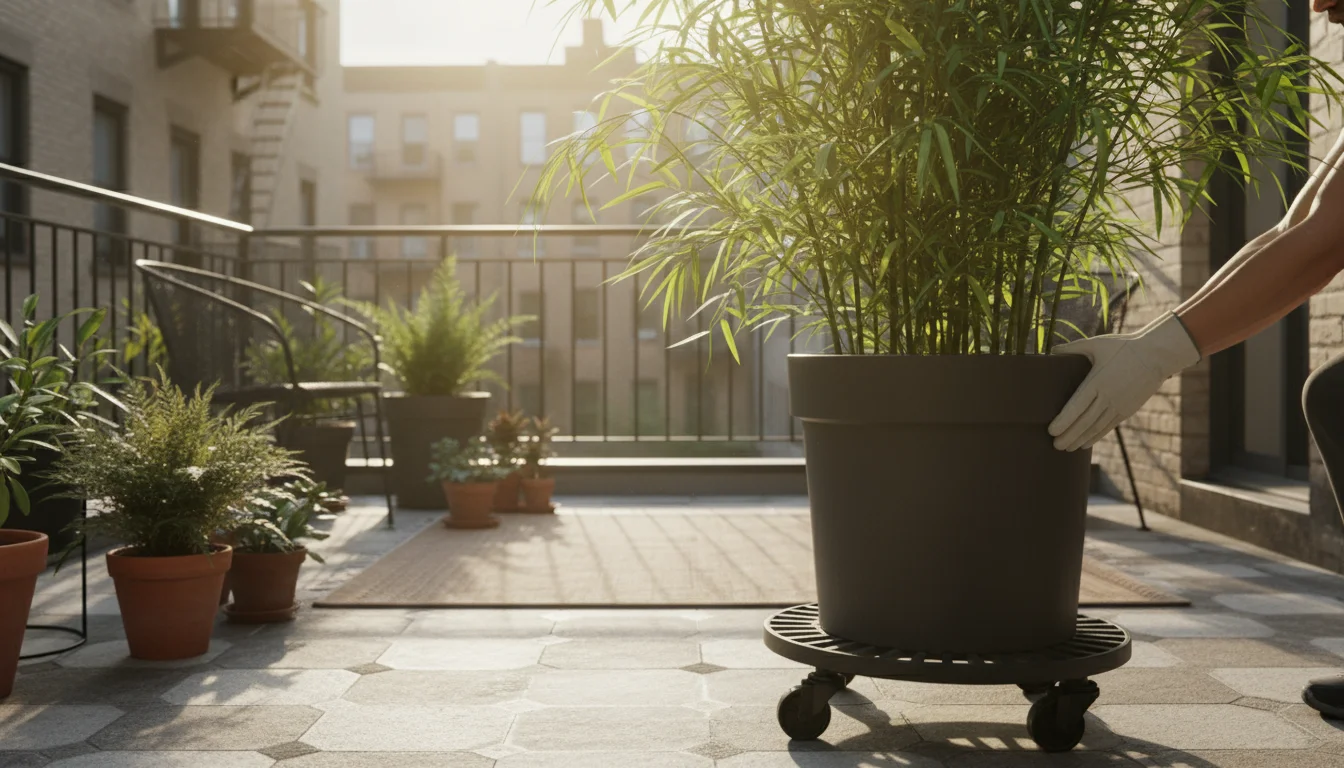
Wheeled Bases for Flexibility
Mobility is a major advantage of container gardening. Equip heavy pots with wheeled bases or casters. This allows you to easily reposition your outdoor privacy plants to block specific sightlines, chase the sun, or move plants indoors during winter. This flexibility becomes invaluable for seasonal privacy adjustments or for reconfiguring your space for gatherings.
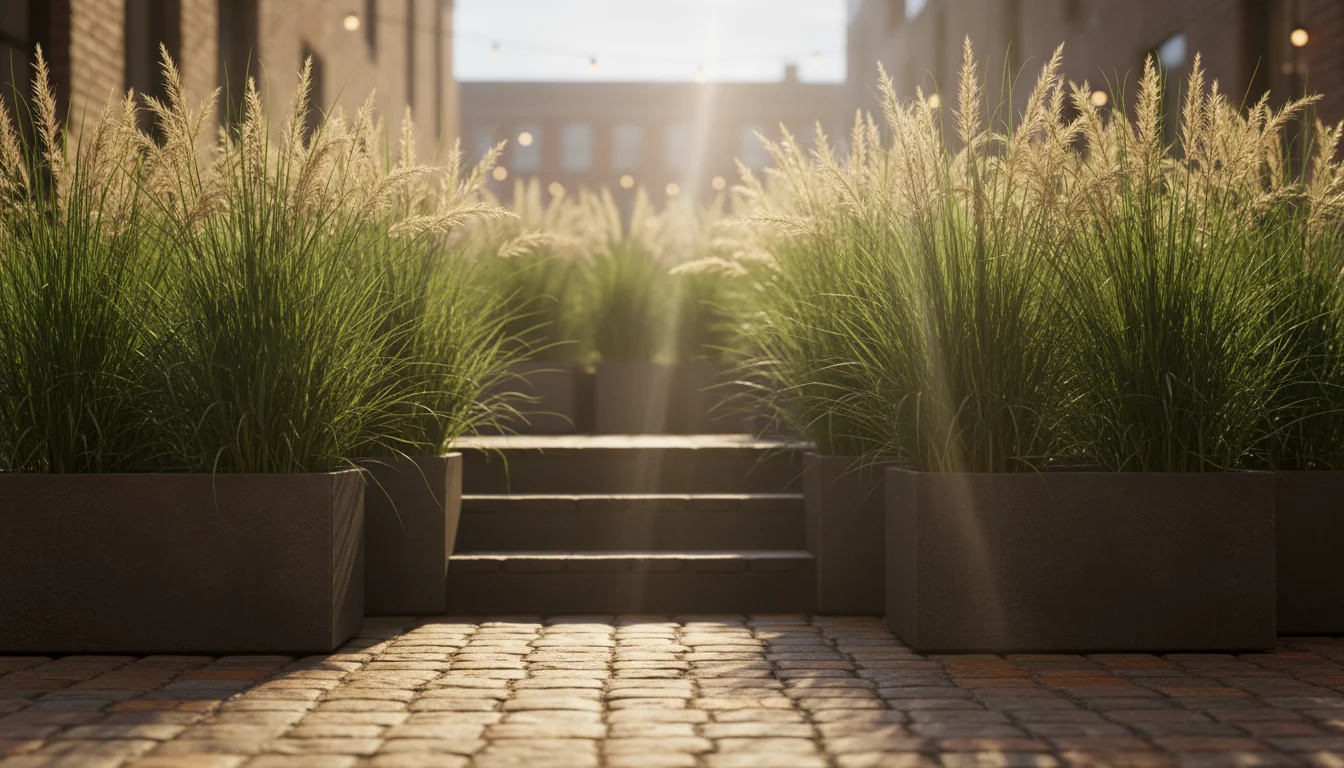
Planting Strategies for Container Privacy
- Block planting: Arrange several identical or complementary pots in a row to form a continuous screen.
- Staggered grouping: Place pots in an alternating pattern to create a deeper, more natural-looking screen.
- Multi-plant containers: Plant multiple specimens of the same species in one large pot to create a denser, wider screen from a single container. For instance, three slender bamboo culms or several bushy grasses in one sizable planter can create a robust visual barrier.
Remember that container plants require more frequent watering and feeding than in-ground plants due to their limited soil volume. Use a high-quality, peat-free potting mix specifically formulated for containers to ensure proper drainage and nutrient retention.
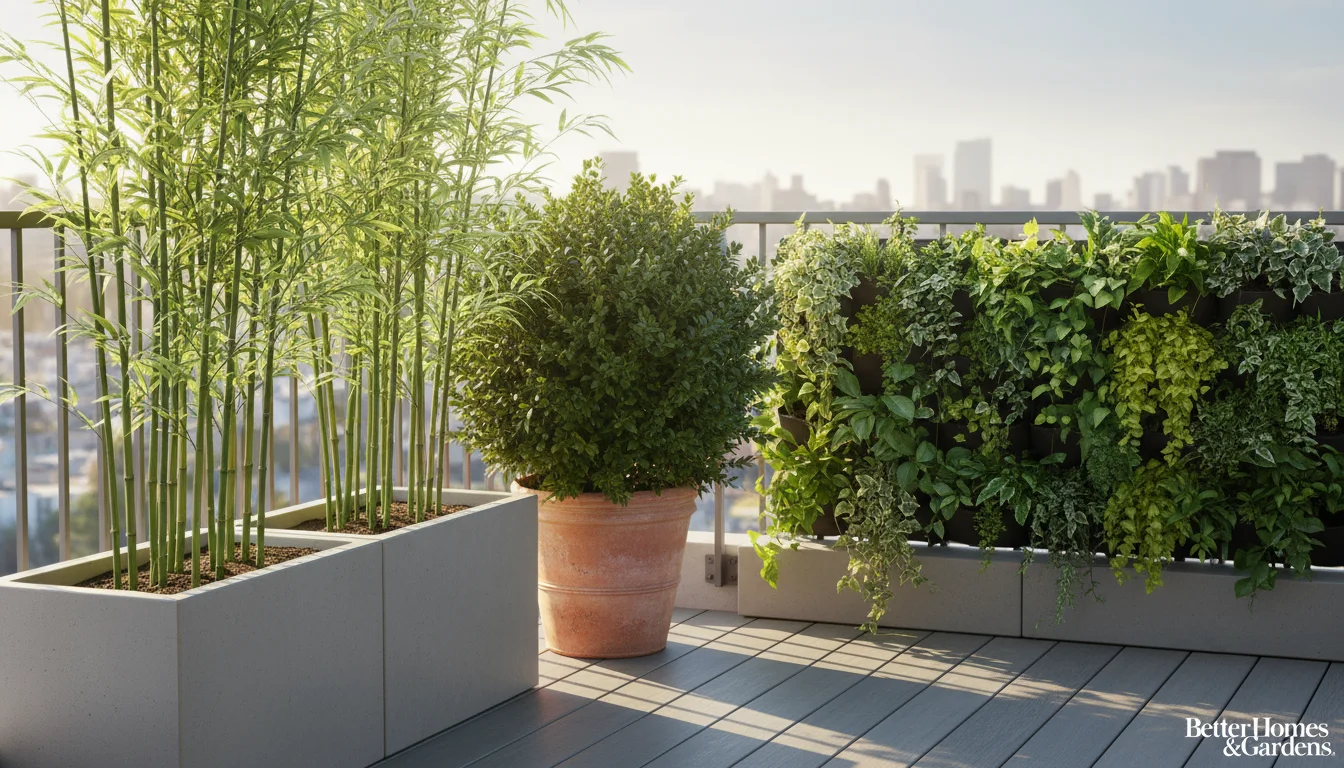
Choosing the Best Outdoor Privacy Plants
Selecting the right plants is critical for creating an effective and low-maintenance privacy screen. You need plants that not only grow well in your specific conditions but also possess characteristics that make them excellent garden screening material. Focus on density, height, and year-round appeal.
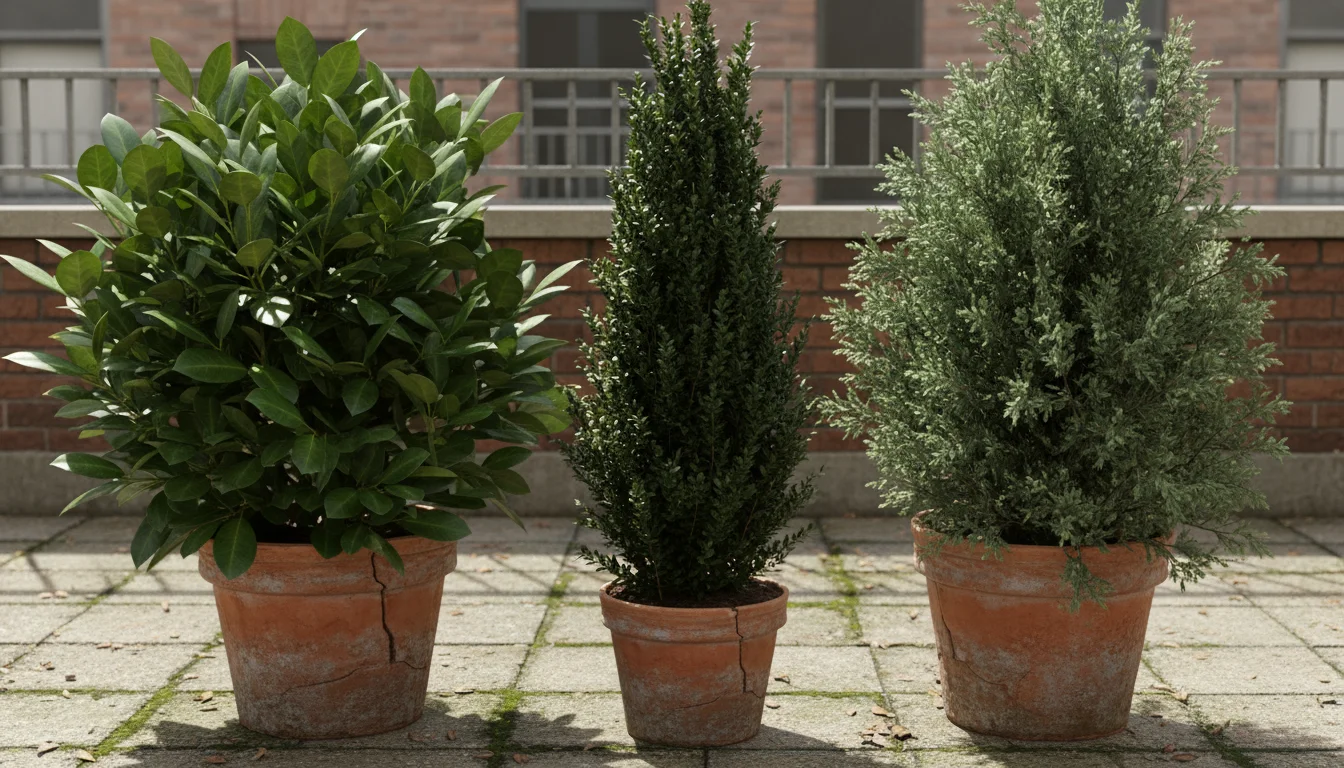
Key Characteristics for Privacy Plants
- Dense Foliage: Look for plants with tightly packed leaves or numerous branches that create an opaque barrier.
- Evergreen: For year-round privacy, prioritize evergreen shrubs, conifers, or broadleaf evergreens. Deciduous plants lose their leaves in winter, diminishing their screening power.
- Mature Size: Always check the mature height and width of a plant. Choose varieties that naturally grow to your desired screening height without excessive pruning. For small spaces, consider dwarf or columnar cultivars.
- Growth Rate: Fast-growing plants provide quicker results, but be aware they may require more frequent pruning.
- Adaptability: Select plants suited to your climate zone (USDA Hardiness Zone), sun exposure, and soil type.
- Low-Maintenance: Opt for plants that resist pests and diseases and do not require constant attention.
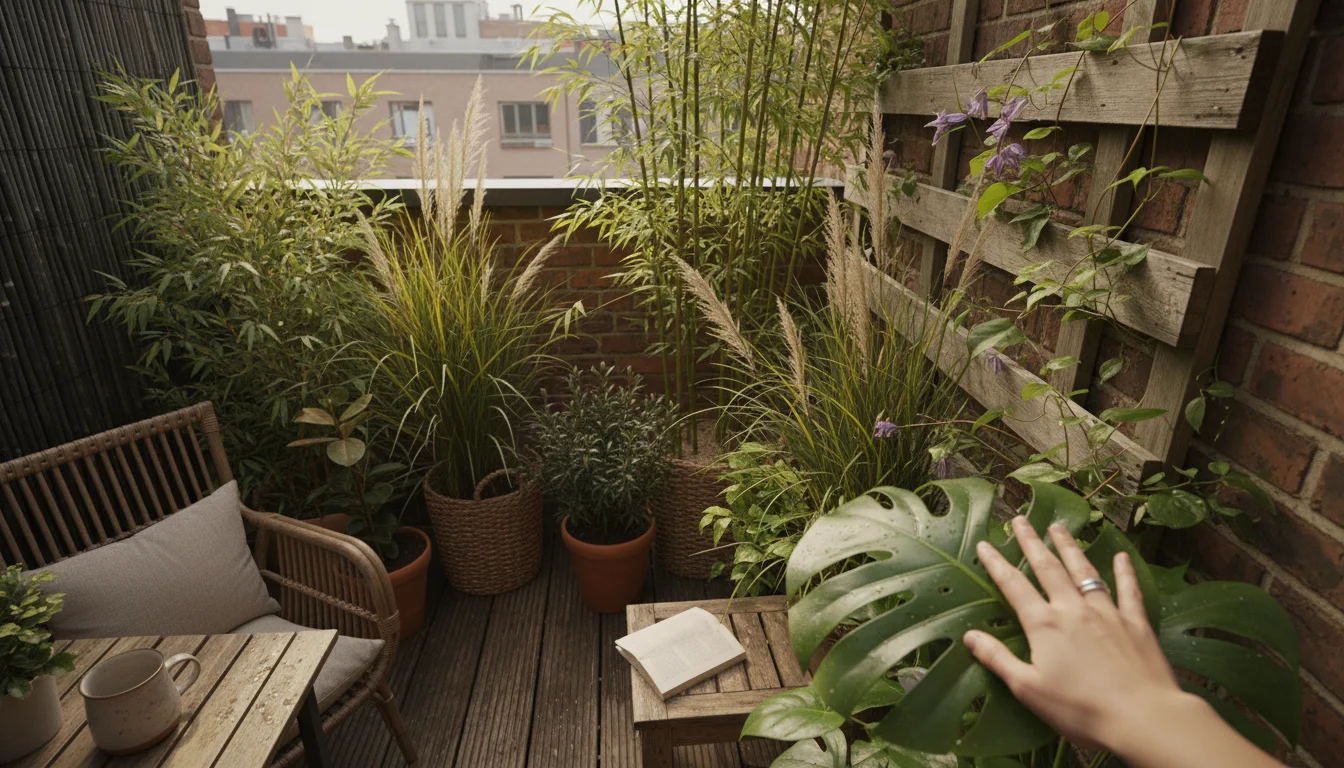
Top Outdoor Privacy Plant Recommendations for Small Spaces
Tall Grasses
Ornamental grasses offer soft, rustling sounds and elegant movement, making them perfect for natural, airy garden screening. They grow quickly and many varieties thrive in containers.
- Fountain Grass (Pennisetum species): Varieties like ‘Hameln’ or ‘Moudry’ reach 2-4 feet tall and wide, creating soft, dense clumps.
- Maiden Grass (Miscanthus sinensis): Taller varieties grow 5-7 feet, providing substantial screening. Choose clumping varieties to avoid invasiveness.
- Bamboo (Fargesia species – Clumping Bamboo): Crucially, select clumping bamboo, not running bamboo, which spreads aggressively. Fargesia varieties like ‘Rufa’ or ‘Green Screen’ are non-invasive, cold-hardy, and create a beautiful, dense screen up to 10-15 feet tall. They are excellent for balcony privacy gardens.
Shrubs and Dwarf Conifers
These provide robust, often evergreen, screening. Dwarf and columnar varieties are ideal for containers and confined spaces.
- Dwarf Conifers (e.g., Dwarf Alberta Spruce, Sky Pencil Holly): Offer dense, narrow forms perfect for tight spots. ‘Sky Pencil’ Holly (Ilex crenata ‘Sky Pencil’) grows tall and slender, reaching 6-8 feet high but only 2 feet wide.
- Boxwood (Buxus sempervirens): Classic, dense evergreen that tolerates pruning into formal shapes. Varieties like ‘Green Mountain’ are upright.
- Laurel (Prunus laurocerasus ‘Otto Luyken’): A dwarf English laurel, it provides glossy evergreen foliage and a dense, upright habit, reaching 3-4 feet tall and wide.
- Arborvitae (Thuja occidentalis ‘Smaragd’ or ‘Emerald Green’): A popular choice for slender, upright evergreen screening, growing 10-15 feet tall but only 3-4 feet wide. Ideal for a continuous hedge in containers.
- Photinia (Photinia x fraseri ‘Red Tip’): Offers vibrant red new growth and evergreen foliage, though it can get large without pruning. Smaller varieties exist.
Vines (as discussed under Vertical Screens)
Remember that vines need a support structure. Revisit the “Vertical Green Screens” section for specific recommendations.
Small Trees
For slightly larger patios or compact yards, small trees can provide excellent overhead and eye-level privacy.
- Columnar Fruiting Trees: Apple or pear trees bred for a narrow, upright habit offer edible privacy.
- Japanese Maple (Acer palmatum varieties): While deciduous, their elegant branching structure still provides some visual break, and specific cultivars like ‘Bloodgood’ offer dense foliage during the growing season.
- Dwarf Citrus Trees (e.g., Meyer Lemon): In suitable climates, these evergreen trees provide fragrant blooms, fruit, and good foliage density. Bring indoors in winter in colder regions.
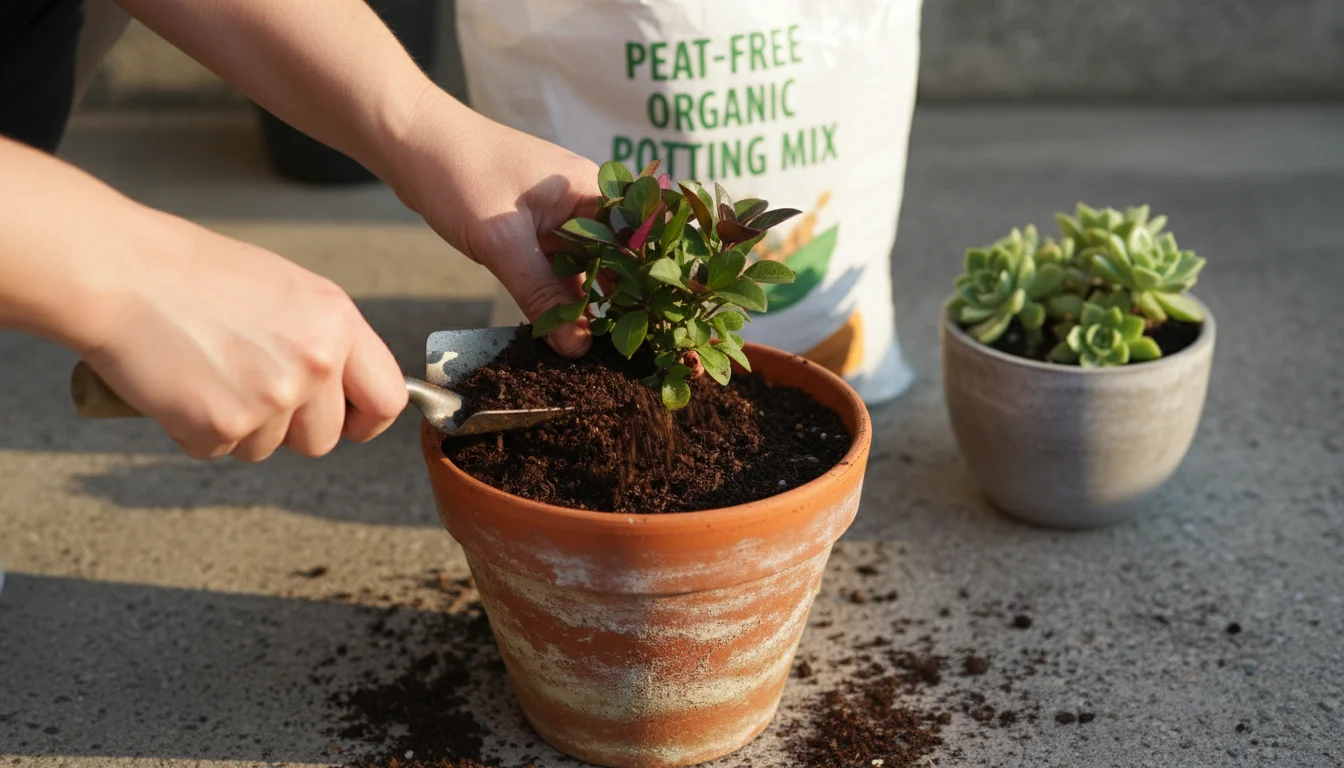
Sustainable Plant Choices
When selecting your outdoor privacy plants, prioritize sustainability. Choose native plants whenever possible, as they adapt better to your local climate, require less water and fertilizer, and support local pollinators and wildlife. Utilize peat-free potting mixes to protect peat bogs, which are vital carbon sinks. Opt for water-wise varieties, especially in drought-prone areas, to conserve resources. Your balcony privacy garden can be both beautiful and environmentally responsible.
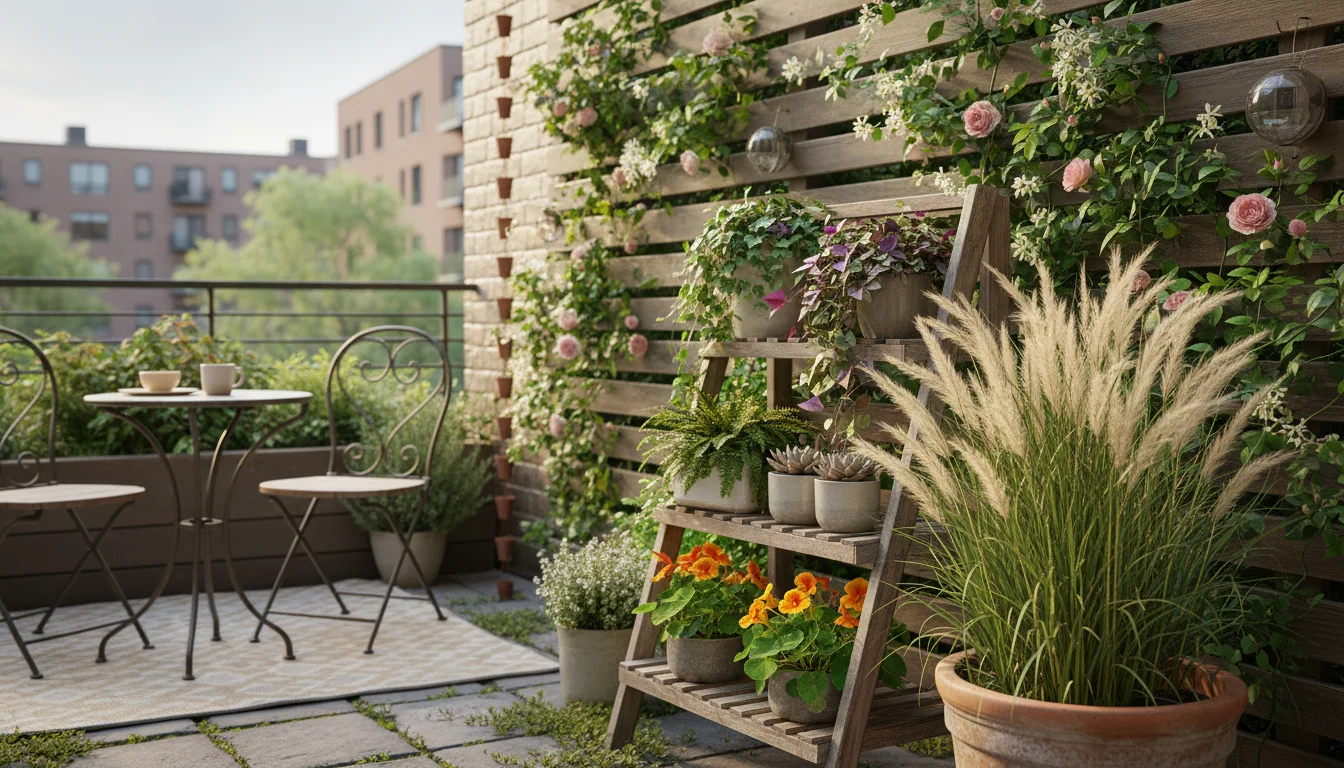
Layers and Textures for Dynamic Screening
A successful privacy garden moves beyond a simple green wall. Incorporating layers, varied textures, and diverse foliage creates a dynamic, visually rich screen that feels natural and inviting. This approach transforms your garden screening from a utilitarian barrier into a captivating landscape feature.
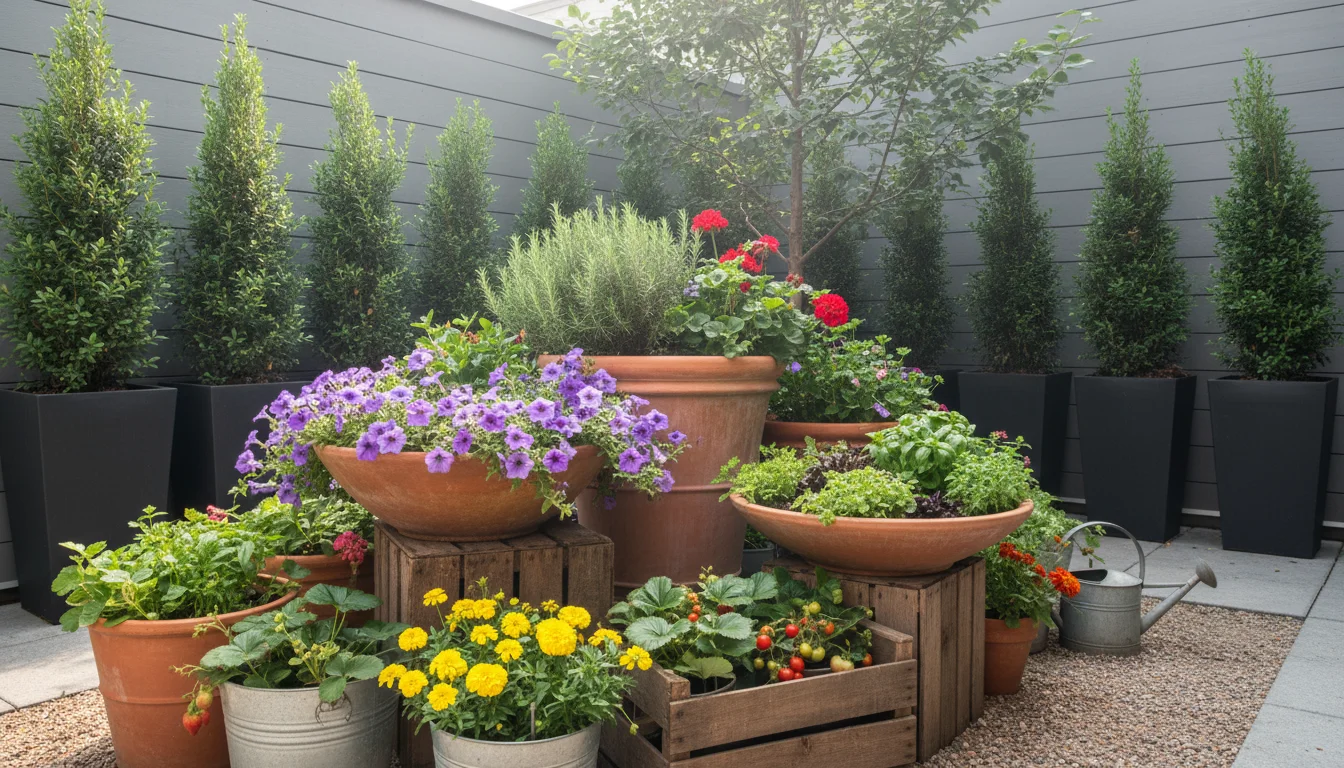
Creating Depth with Layers
Think about your privacy screen in terms of foreground, middle ground, and background. Taller plants form the background, providing the main screening. In front, place medium-height plants that add density and interest. Finally, add lower-growing plants or trailing elements at the base to soften the edges of your containers or beds. This layering creates visual depth, making your small space feel more expansive and less like a flat wall.
- Background: Tall shrubs, columnar trees, or climbing vines on a trellis.
- Mid-ground: Bushy perennials, smaller evergreen shrubs, or dense ornamental grasses.
- Foreground: Trailing annuals, compact herbs, or low-growing groundcovers that spill over container edges.
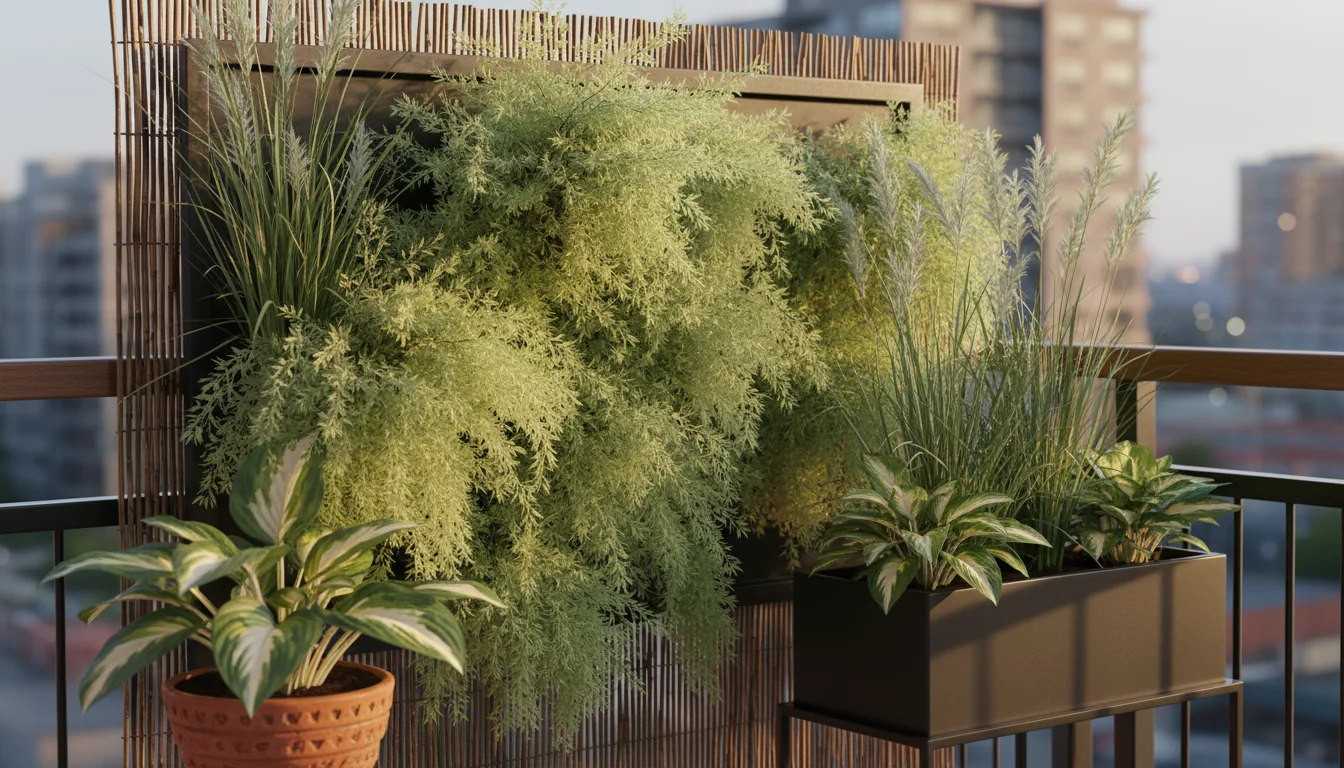
Varying Foliage for Texture and Interest
Foliage provides the primary visual interest in a privacy garden, especially for evergreens. Incorporate plants with different leaf shapes, sizes, and colors. A mix of fine-textured grasses, broad-leaved hostas, and feathery ferns creates a rich tapestry. Consider plants with variegated leaves, which offer bright splashes of color without relying on blooms. The contrast in textures adds a tactile quality to your garden screening, inviting closer inspection.
- Fine texture: Maiden grass, asparagus fern, conifers with needle-like foliage.
- Medium texture: Boxwood, laurels, most perennials with average-sized leaves.
- Bold texture: Hostas, large-leaved tropicals (if applicable to your climate), some ornamental kale.
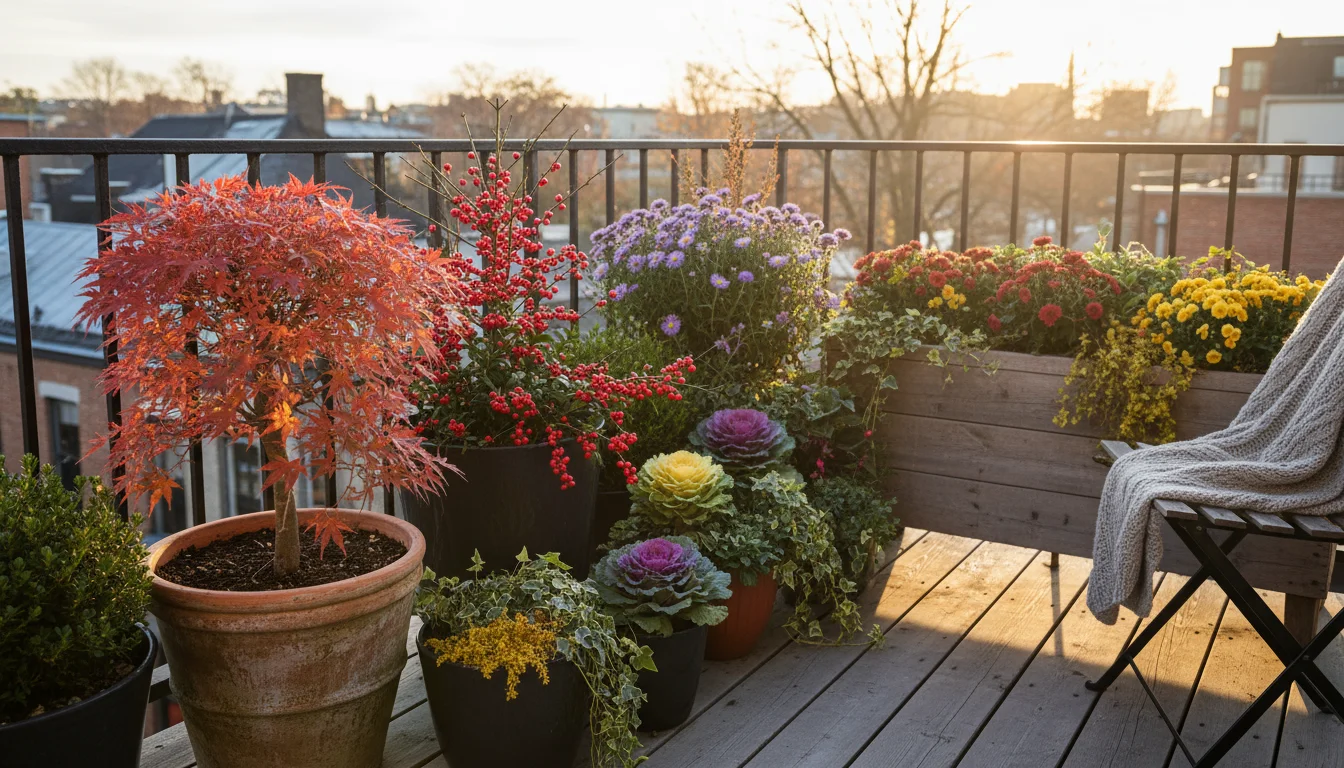
Seasonal Interest Beyond Green
While evergreen plants provide year-round privacy, integrating deciduous plants or those with seasonal features adds dynamic interest. Choose plants that offer more than just green leaves:
- Flowering plants: Introduce plants with blooms that appear at different times of the year. Consider spring-flowering clematis, summer-blooming hydrangeas, or fall-blooming asters.
- Fall color: Deciduous trees or shrubs like Japanese maples offer brilliant autumn foliage before dropping their leaves.
- Winter interest: Plants with interesting bark, berries, or persistent seed heads provide structure and color during the colder months. Think of certain dogwood varieties with colorful stems or winterberry hollies with bright red berries.
A well-designed balcony privacy garden balances continuous green screening with elements that change and evolve throughout the seasons. This keeps your outdoor space vibrant and engaging year-round.
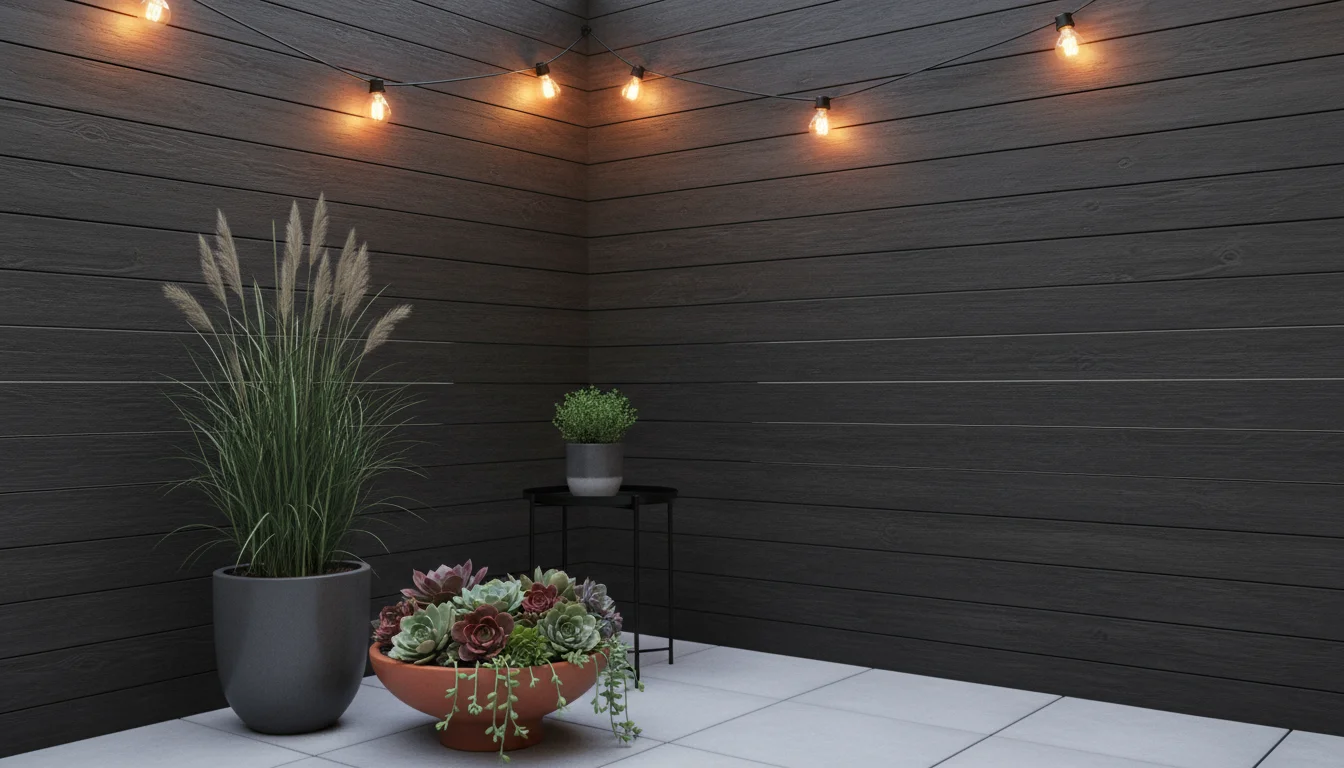
Beyond Plants: Integrating Structures and Sound
While plants form the heart of your privacy solution, combining them with structural elements and sound strategies enhances their effectiveness. These additions offer immediate screening, define your space, and contribute to a more comprehensive sense of seclusion in your balcony privacy garden or patio.
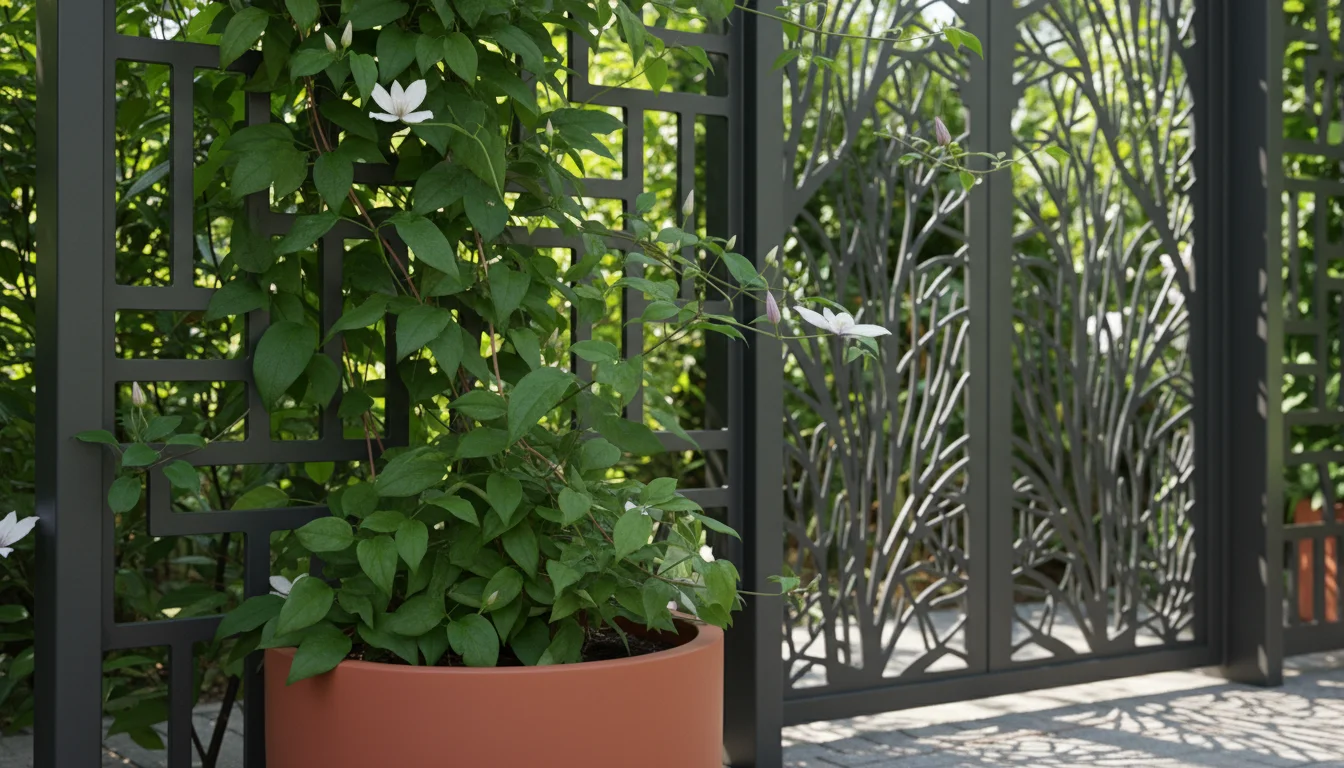
Lattice and Decorative Panels
Lattice panels provide an excellent framework for climbing plants and offer instant, though partial, screening. They come in various patterns and materials, from classic wood lattice to more modern metal or composite panels. Install lattice as an extension of a low wall, along a railing, or as a freestanding screen. The open pattern allows light and air to pass through while still obscuring direct views. Once climbing plants grow over the lattice, it becomes an even denser, more beautiful garden screen. Decorative screens, such as laser-cut metal panels or bamboo roll fencing, offer immediate visual barriers with architectural appeal. You can position these behind or among your outdoor privacy plants to achieve faster, more complete coverage.
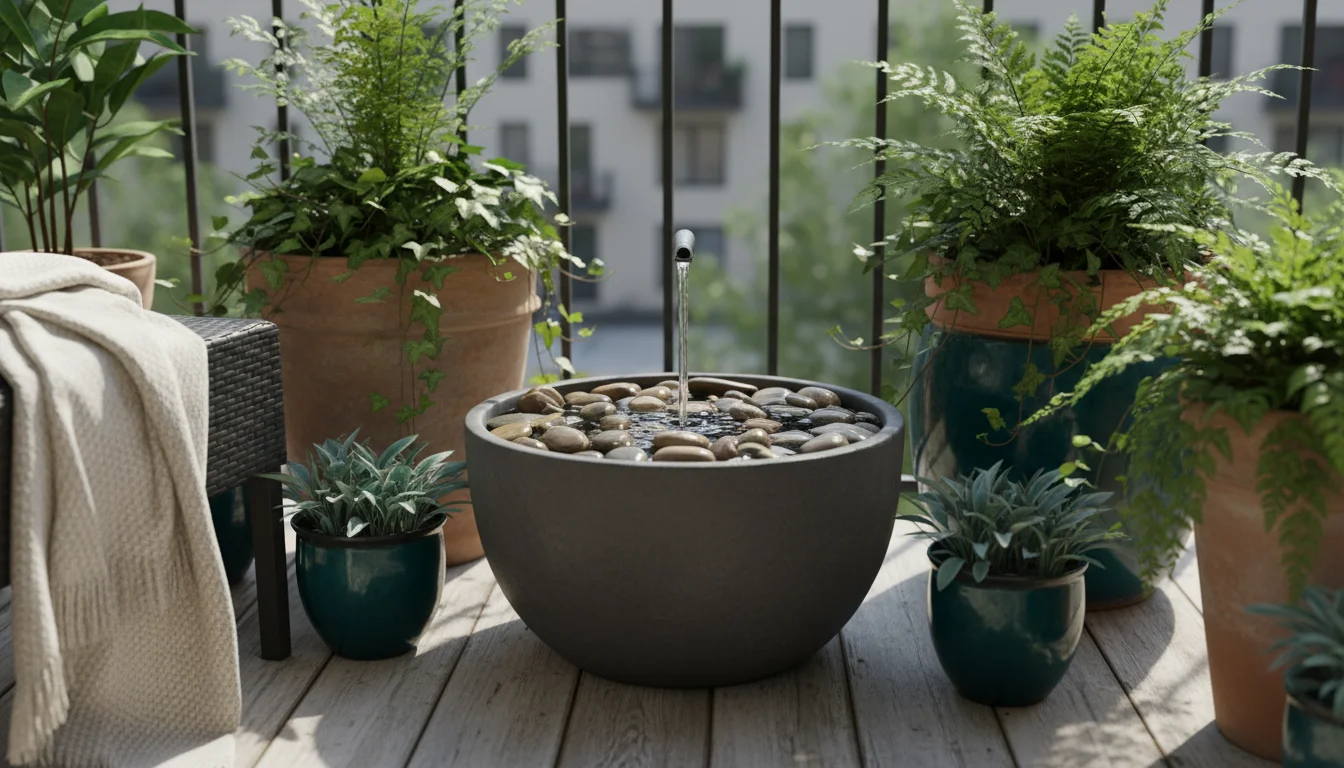
Water Features for Sound Softening
The gentle sounds of trickling water from a small fountain or water feature offer more than just aesthetic appeal; they actively contribute to privacy. A soothing water sound helps mask undesirable ambient noises like traffic, distant conversations, or general city bustle. This acoustic screening creates a more peaceful and intimate atmosphere, enhancing the sense of a secluded oasis. Choose a compact, recirculating fountain suitable for your small space, ensuring it is easy to maintain and has a pleasant, consistent sound.
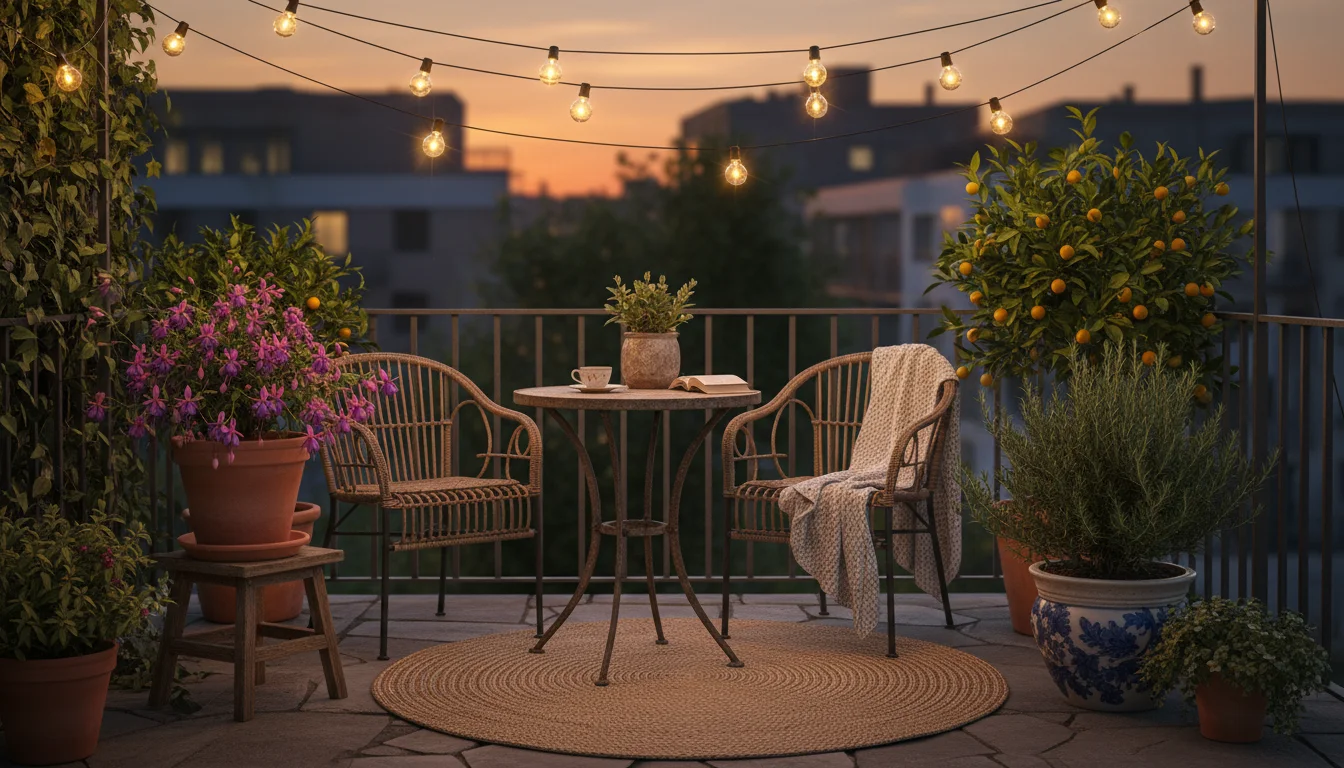
Strategic Lighting for Evening Use
Thoughtful lighting extends the usability of your outdoor space into the evening hours and contributes to a sense of privacy. String lights draped across a trellis or overhead create a cozy, enclosed feeling, defining the boundaries of your outdoor room. Solar-powered stakes can illuminate pathways and highlight your garden screening plants. Avoid harsh, upward-shining lights that can create glare or draw attention to areas you want to keep private. Instead, opt for soft, downward-facing lights that cast a warm glow, enhancing the ambiance and creating a sense of intimacy. Position lights to illuminate your plants, showcasing their beauty even after sunset. Always prioritize low-voltage, outdoor-rated lighting for safety and efficiency.
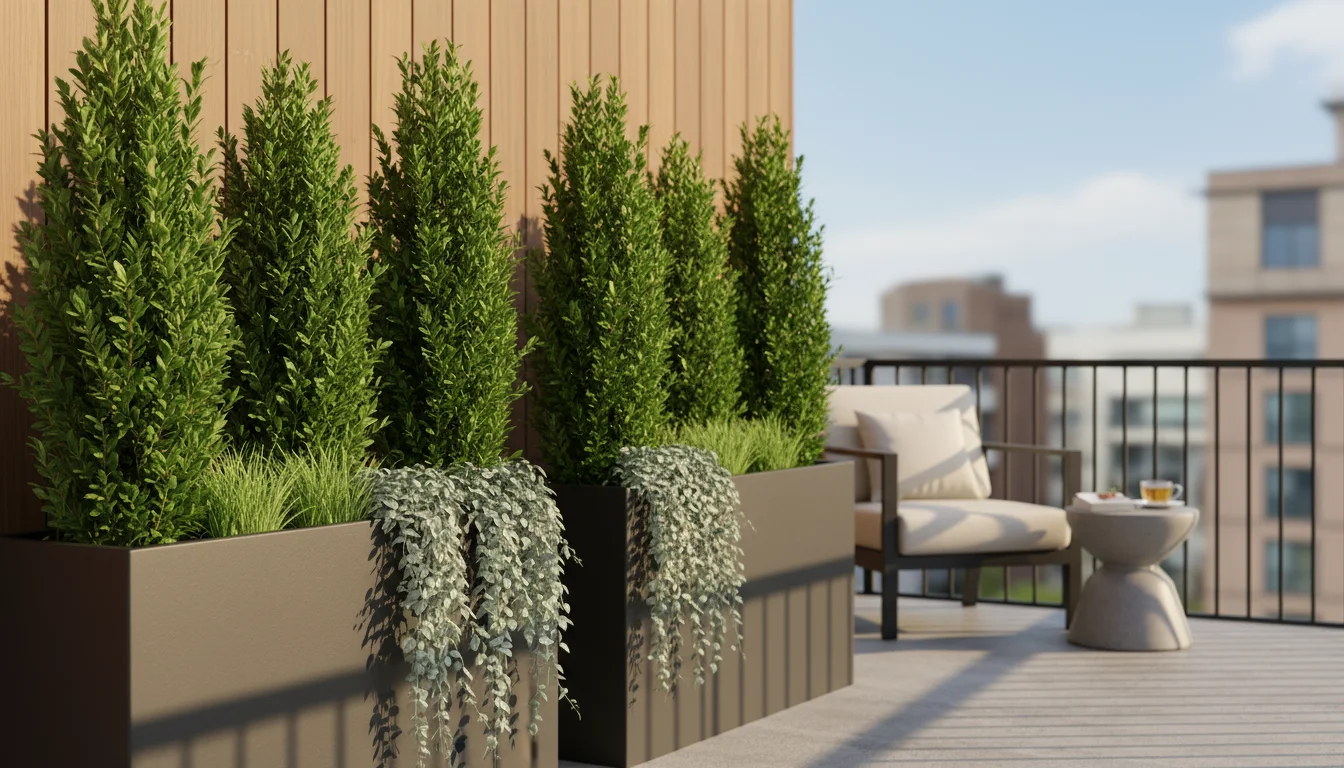
Low-Maintenance Privacy Tips for Lasting Enjoyment
The goal of any small-space garden, especially a balcony privacy garden, should include ease of care. A low-maintenance approach ensures your living screen remains beautiful and effective without demanding excessive time or effort. Designing for minimal upkeep means selecting the right plants and implementing smart gardening practices from the outset.
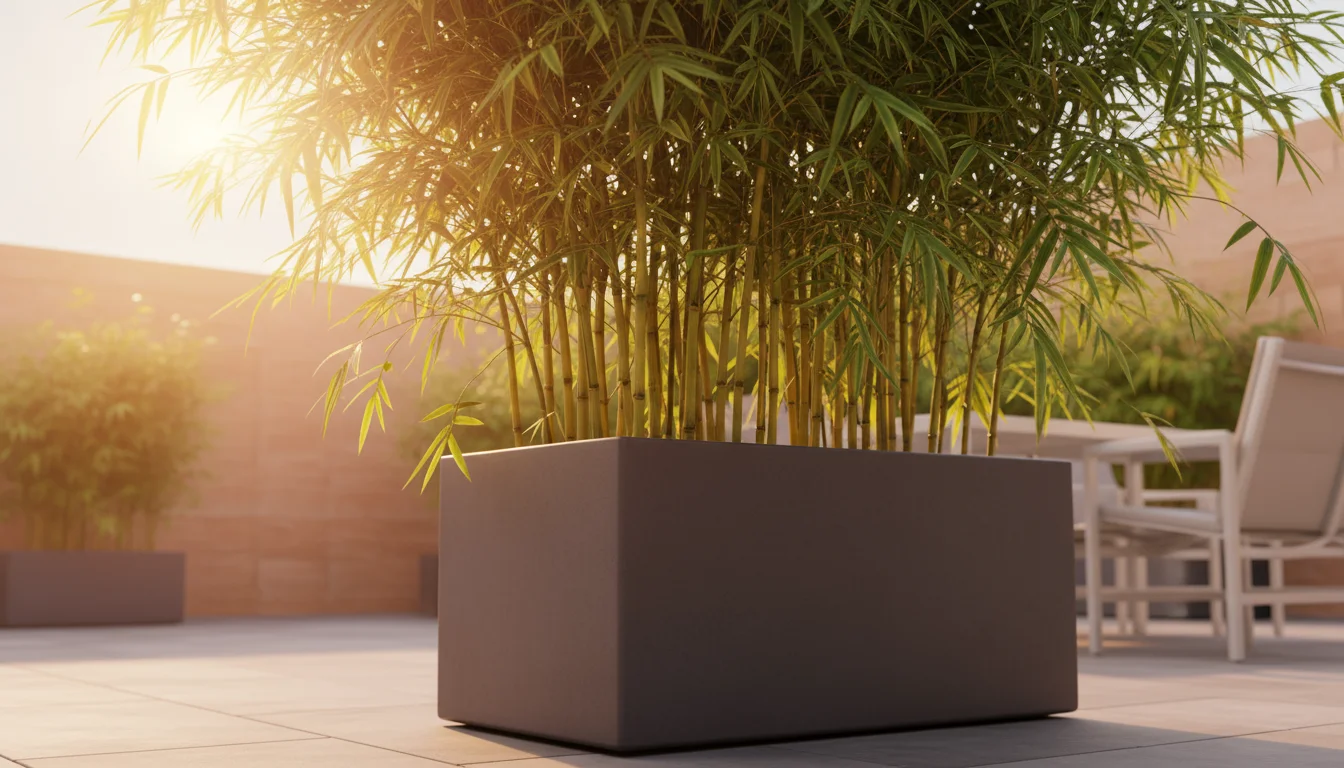
Right Plant, Right Place
This fundamental gardening principle becomes even more critical for low-maintenance privacy. When you choose outdoor privacy plants that thrive in your specific conditions—sun exposure, soil type, and climate—they naturally resist pests and diseases, grow vigorously, and require less intervention. For example, planting a sun-loving plant in deep shade leads to weak growth and increased vulnerability to problems. Conversely, placing a shade-lover in full sun causes scorching and stress. Research your plant choices thoroughly to match them perfectly with your environment.
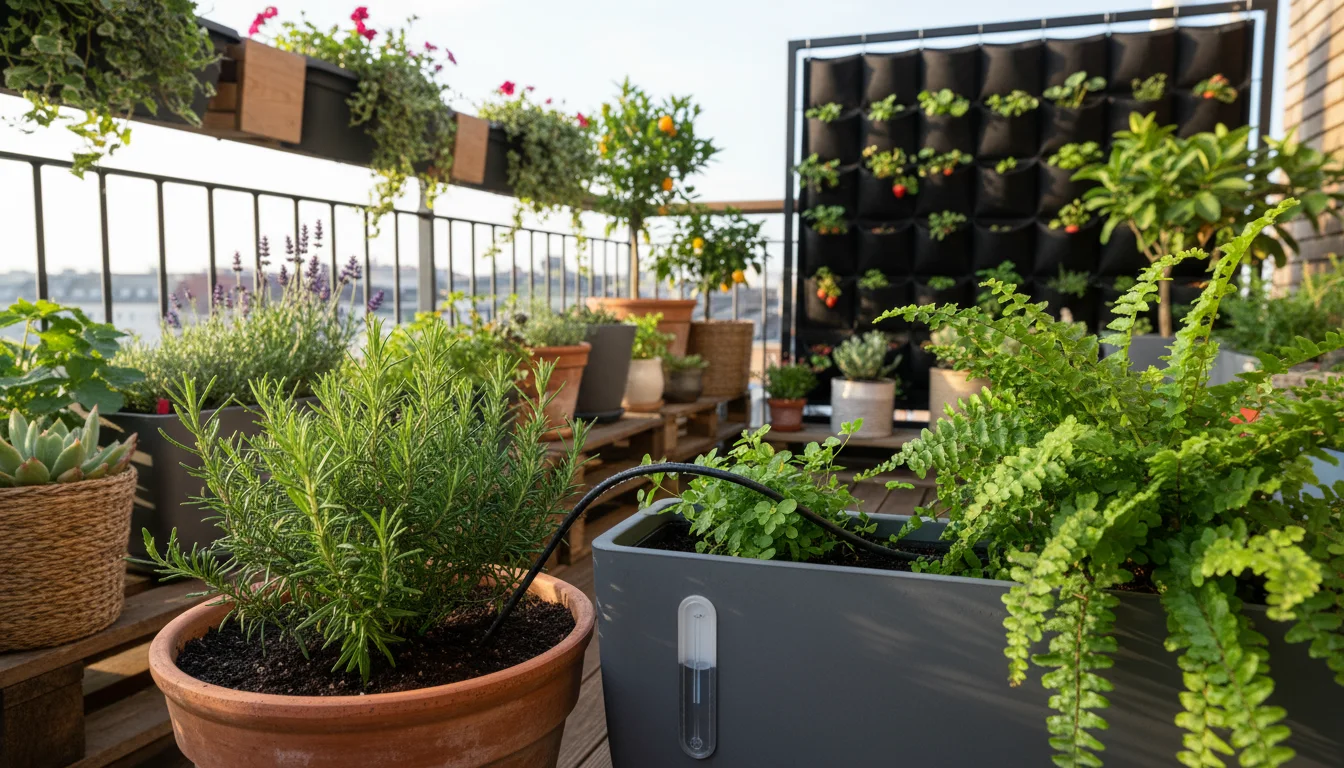
Efficient Watering Systems
Container plants and vertical gardens dry out faster than in-ground plantings. An efficient watering system significantly reduces manual labor. Consider installing a simple drip irrigation system or using self-watering planters. Drip irrigation delivers water directly to the plant roots, minimizing waste and ensuring consistent moisture levels. Self-watering planters feature a reservoir that releases water as the plant needs it, extending the time between waterings. These solutions are particularly beneficial for busy individuals or during periods of travel, ensuring your garden screening stays hydrated.
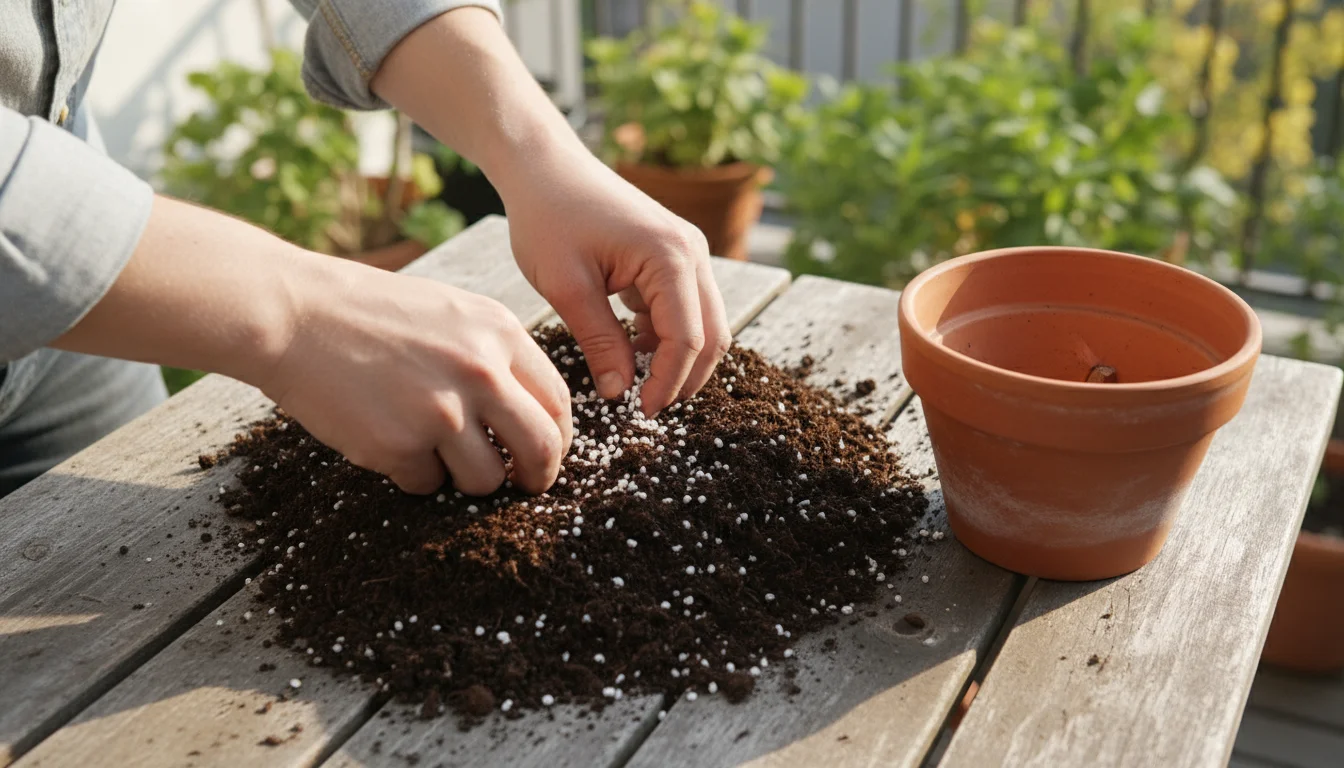
Quality Potting Mixes and Fertilization
Invest in high-quality, peat-free potting mixes. Good mixes provide excellent drainage while retaining sufficient moisture and nutrients. They offer a healthier environment for roots, leading to stronger, more resilient plants. Incorporate a slow-release granular fertilizer at planting or during annual repotting. This provides a steady supply of nutrients over several months, reducing the need for frequent liquid feeding. Healthy, well-fed plants grow denser foliage, creating a more effective privacy screen and minimizing maintenance issues.
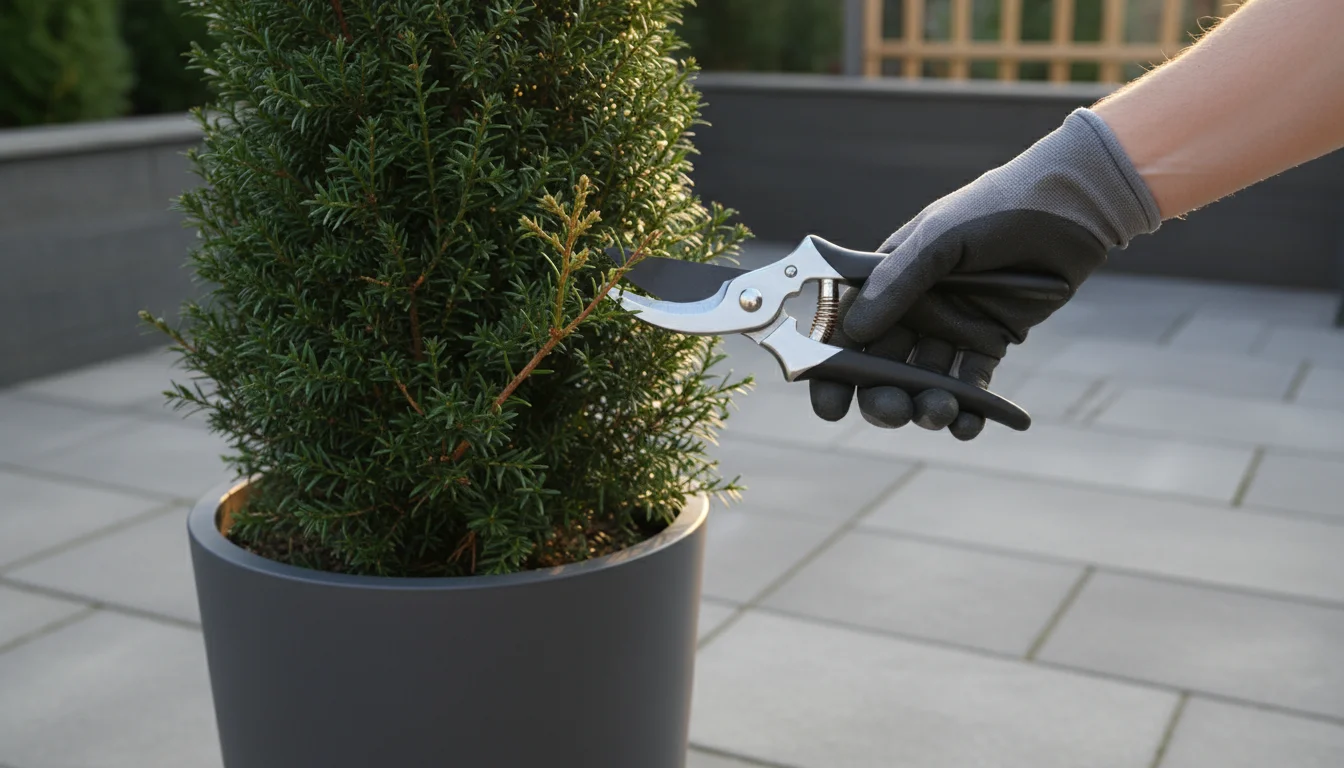
Strategic Pruning
While some plants require regular pruning to maintain their shape and density, strategic choices can minimize this task. Select plants with a naturally compact or columnar growth habit that closely matches your desired screening size. When pruning, aim for selective removal of dead, damaged, or crossing branches. For shaping, a light, regular trim helps maintain density and encourages branching, making your garden screening fuller. Avoid drastic pruning, which can stress plants and reduce their vigor. Always use clean, sharp tools for pruning to prevent disease.
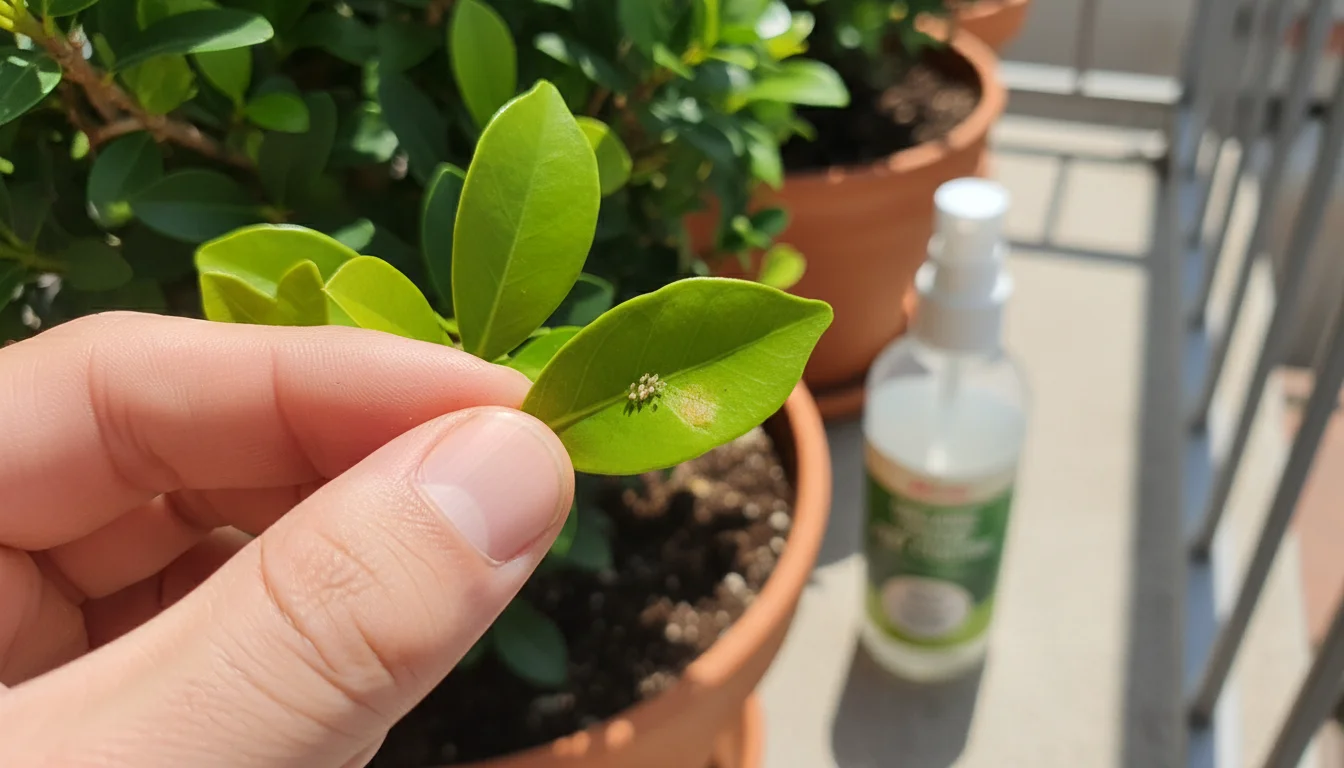
Pest and Disease Management
Healthy plants are the best defense against pests and diseases. Regular observation allows you to catch problems early, when they are easier to manage. Inspect your outdoor privacy plants weekly for any signs of trouble, such as discolored leaves, sticky residue, or visible insects. Address issues promptly with organic solutions when possible, such as insecticidal soap for aphids or manual removal of slugs. A robust, low-stress plant environment significantly reduces your need for intensive pest and disease intervention, contributing to a truly low-maintenance balcony privacy garden.
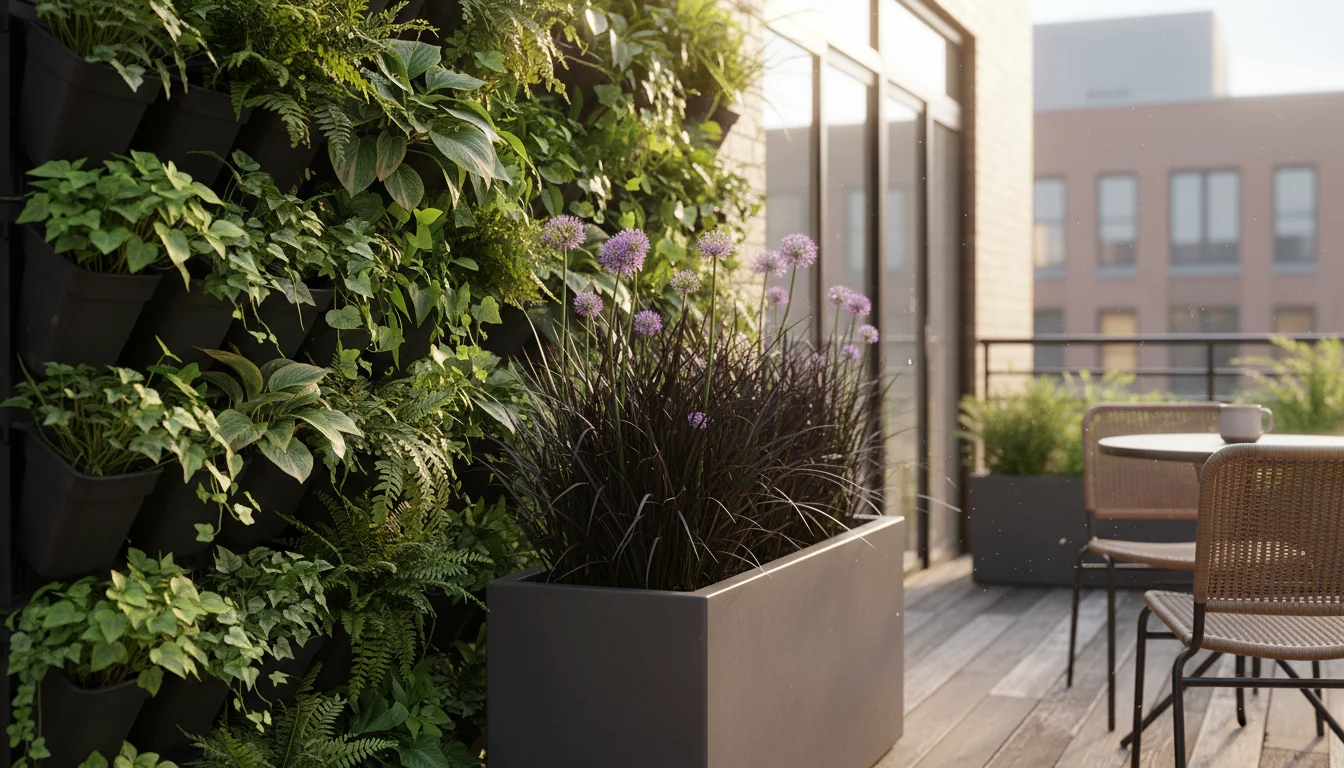
Frequently Asked Questions
How fast can I get privacy using plants?
You can achieve privacy relatively quickly by combining fast-growing outdoor privacy plants with immediate structural elements. Select quick-growing vines like native honeysuckle or morning glory (as an annual) on a trellis, or fast-growing ornamental grasses such as maiden grass. For more immediate visual blockage, place dense evergreen shrubs like columnar arborvitae in large containers and supplement with decorative lattice panels or bamboo screens until your plants mature.
What plants work best for windy balconies?
For windy balconies, choose sturdy plants with flexible stems and compact or narrow leaves that resist wind damage. Good choices include ornamental grasses such as fountain grass or maiden grass, which sway with the wind rather than breaking. Dwarf conifers like ‘Sky Pencil’ holly or compact boxwood also tolerate wind well due to their dense structure. Ensure all containers are heavy enough or secured to prevent tipping.
Can I create privacy without blocking all light?
Absolutely. You can create effective garden screening that still allows ample light to filter through. Use plants with a more open growth habit, or choose a layered approach where taller plants are strategically placed only where direct sightlines occur. Trellises with climbing vines offer partial privacy and light filtration, as do decorative panels with open patterns. Positioning plants to block only specific angles, rather than creating a solid wall, maintains brightness in your outdoor space.
How do I choose the right container size for privacy plants?
Choose containers large enough to accommodate the plant’s mature root system. For most shrubs and tall grasses used for privacy, this means a pot with a minimum diameter and depth of 18-24 inches (45-60 cm) or larger. A larger soil volume provides better insulation for roots, reduces watering frequency, and allows the plant to develop a robust root system, which supports denser top growth. Always ensure containers have adequate drainage holes.
What is the most environmentally friendly way to create plant-based privacy?
The most environmentally friendly approach involves selecting native plants adapted to your local climate, as they require less water and support local ecosystems. Use peat-free, organic potting mixes and incorporate slow-release, organic fertilizers. Collect rainwater for irrigation if possible, and choose water-wise plant varieties. Avoid invasive species and prioritize plants that are naturally pest and disease resistant, minimizing the need for chemical treatments. This sustainable strategy benefits both your garden and the wider environment.
